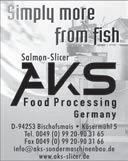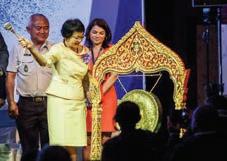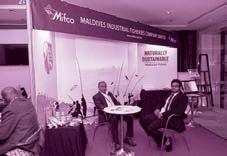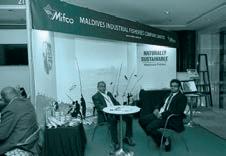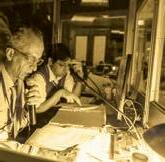






The Albanian fisheries and aquaculture sector is multifaceted. Capture fishing is practiced in the Adriatic Sea, along the coast, in inland waters, and coastal lagoons. Fish farmers cultivate fish and shellfish in the sea and grow fish in freshwater in dam lakes, raceways, and net cages. Fishers use different gears includ ing trawls, seines, dredges, and gillnets to target a variety of species, and their vessels are classified into large- and small scale with the former measuring more than 12 m in length. Catches have remained largely stable over the last five years, but the industry is seeing a growing number of non-native species and has to contend with growing volumes of plastic litter in the sea. Production from aquaculture has more than dou bled over the last five years with the bulk of the volume coming from seabass, seabream, and rainbow trout farming while carp species grown in polyculture make up the balance. However, the sector faces challeng es such as a shortage of labour, the lack of allocated zones, and the need to adapt to higher temperatures. Addressing these will allow development to continue as it has in the past. Read more from page 16
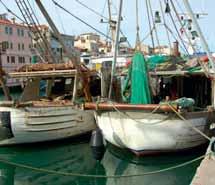

Support to the fisheries sector from governments takes a variety of forms—fuel subsidies, vessel decom missioning, research, monitoring and control, stock management, infrastructure, and direct contributions to fisher’s incomes. The purpose of the support is typically to improve fishers’ welfare, maintain employ ment in the sector, or enhance the sustainability of the activity. However, many forms of subsidy, such as for fuel or vessel renewal (input subsidies), also contribute to an increase in fishing capacity and to overfishing. This means that while fishers profit from subsidies the rest of the population pays the price of depleted stocks and declining biodiversity in the oceans. Globally, subsidies are estimated to cost between USD14 and 54bn a year with one 2019 study from Canada calculating them at USD35bn. And there are vast disparities in the way they are distributed both within and between countries with wealthy countries and large vessels responsible for a disproportionate share. For these reasons and because taming subsidies is an objective un der one of the UN’s sustainable development goals subsidies need to be eliminated. The agreement reached recently at the WTO is a step in this direction. Read Dr Manfred Klinkhardt’s article from page 34
Vegan and vegetarian seafood products are a growing sector of the food industry. The Global Food Institute (GFI) estimates that the vegan meat market is worth almost 1.4 billion dollars with fish and seafood making up 1 of the vegan meat alternatives market. This sector is growing, and it is estimated that the trade in vegan fish products will grow by 28 annually until 2031. This is because despite a consumer’s decision to be vegan or vegetarian, many consumers still want a product that tastes like fish or meat. The production of fake fish requires vast expertise in the production process, so the product replicates fish texture, flavour, microbiology, and nutritional profile. For this reason, fish alternatives have many ingredients such as thickening agents, acid ity regulators, aromas, and preservatives intended to make them taste like fish. However, natural fish are high in bioavailable protein, essential amino acids, and omega-3 fatty acids. Alternative fish products lack these nu tritional benefits and adding these nutrients is expensive and energy intensive. Current complaints about fish alternatives include that the products aren’t organic, they smell is too fishy, and they taste too much like chicken or vegetables. Vegan fish alternatives have a market of willing buyers, however, production challenges have yet to be solved. Read more from page 38

While the war in Ukraine is being felt around the world because of its impact on cereal and oilseed exports from Uksraine which in turn are contributing to global inflation, the effect on the Ukrainian aquaculture industry has been largely confined to the country itself. However, for those that are affected the situation is no less serious. The fall in production of farmed and wild fish threatens the consumption of fish products throughout Ukraine. Processing facilities have either been destroyed or are working only part time due to the difficulties in getting raw material both domestically sourced and imported. A study conducted by the Methodological and Technological Center for Aquaculture, a Ukrainian consultancy based in Kiev, has tried to analyse the war’s impact by gathering information using questionnaires addressed to the indus try, reports Yuri Sharylo, the director of the center. However, in areas that are occupied or where military operations are being conducted it has not been possible to survey the industry and information will only be forthcoming when hostilities end. In the longer perspective the development of the aquaculture sector has been prioritised by the government. Several initiatives have been taken that should revitalise the sec tor after the war. Like the rest of the economy fish farming is suffering, but hopefully it is only temporary. Read more on page 46




























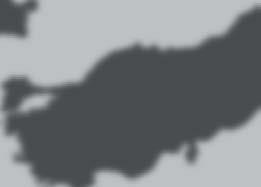

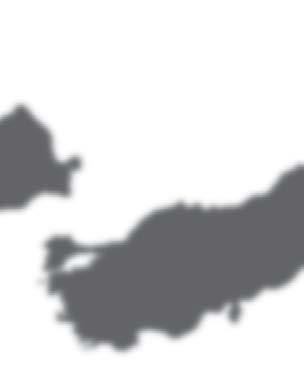








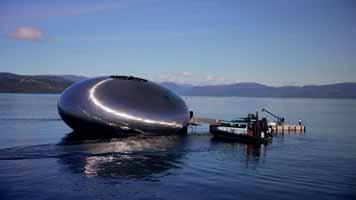
The Salmon Eye, a futuristic construction that floats on the sea in the Hardangerfjord in Norway was launched early September at a hybrid event featuring viewers from around the world and an audience at the site itself. Eide Fjordbruk, the company behind the Salmon Eye, is a farmed salmon producer that is committed to the sustainability of its activities. The construction itself is expected to contribute to a more sustainable seafood production that does not burden the environment but in fact helps to solve the challenges thrown up by climate change. At the same time it is intended to cement Norway’s position as a leading seafood
nation with a farmed fish industry that will play a role in food security for the world’s growing population. Technological development and innovative solutions are the way to meet these objectives and the Salmon Eye, itself a product of technology and vision, has been created to change the way seafood is produced. As climate and environmental regulations become more stringent in the coming years the pressure to produce more sustainably will only increase. Eide Fjordbruk is already looking at new solutions for climate neutral production including for collecting and reusing sludge from sea cages. Initiatives like the Salmon Eye promote
The Salmon Eye was created by the company Eide Fjordbruk to change how seafood is produced and to contribute to sustainable food production that meets the UN’s objectives.
an open and transparent dialogue between the stakeholders in the industry where the problems and the potential of aquaculture
can be freely discussed with the ultimate goal of strengthening the Norwegian maritime food industry.
The Lexicon of Sustainability and the Global Sustainable Seafood Initiative (GSSI), with technical support from the Food and Agriculture Organisation (FAO) launched the Greener Blue initiative as a part of the FAO International Year of Artisanal Fisheries and Aquaculture. The Greener Blue initiative aims to highlight contributions from artisanal and small-scale fishermen to sustainable food systems and the eradication of poverty. The Greener Blue initiative sought people willing to participate in the project’s “Storytelling Lab” which provided participants with the opportunity to build skills and receive mentorship while acquiring a database of stories from artisanal fishermen. The project gave participants a GoPro camera to keep in return for the fishermen telling their stories. The objective is to celebrate the importance of fishermen and
Greener blue is a storytelling initiative that is part of the FAO International Year of Artisanal Fisheries.

farmers in addressing climate change and protecting ecosystems. Farmers and fishermen have
immense firsthand knowledge, and the initiative plans to build a knowledge sharing platform,
Seafood MAP, to provide a place for stakeholders to learn, connect, and develop solutions.
Researchers from the University of Stirling have identified an exciting potential for integrated multi-trophic aquaculture (IMTA) using sea cucumbers and farmed fish. The research stems from the European Union’s Horizon 2020-funded project “Tools for Assessment and Planning of Aquaculture Sustainability (TAPAS)” and was carried out with the AquaBiotech Group and the University of Palermo. The study found that sea cucumbers flourish by feeding on organic waste from commercial fish farms. The sea
cucumbers consume the fish waste which can effectively mitigate the environmental impacts of organic waste accumulation from fish farming. Using stable isotopes and fatty acid analysis the researchers found that fish waste was the dominant food source for the sea cucumbers contributing to their health and growth. Sea cucumber is a delicacy in parts of Asia. It has nutritional properties and is currently being researched for potential medicinal and other health benefits. The demand for sea cucumber is very high and it
New research suggests that sea cucumbers could be used in multi-tropic aquaculture to mitigate accumulation of organic waste from fish farms.
is being over-fished in regions of the world. Sea cucumber can sell for €30/kg dried and €120/kg as processed product in the
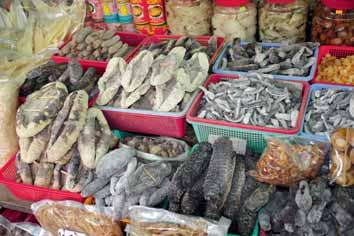
market. The IMTA approach could be a profitable and more environmentally beneficial way of producing fish.


Stakeholders concerned with fishing pressures on the English Channel saw a minor victory when the European Parliament voted to ban demersal seine fishing in parts of the channel. The demersal seine fishing technique, also referred to as fly shooting, has received criticism recently for
putting too much pressure on the channel fishery and having significant effects on small scale fishermen. It is estimated that there are around 75 demersal fishing vessels operating in the channel which is significantly higher than the fishery can support. The EU parliament’s vote on the ban of
The use of plankton in salmon feed is an innovative step in ensuring sustainable salmon aquaculture and the most efficient aquaculture production. Since plankton is a natural prey for salmon, the use of it in aquaculture can help optimize the salmon’s nutrition. For this reason, the Norwegian salmon producer Andfjord has entered into an agreement with Skretting and Zooca to develop a fish food tailored for their on-land flow through salmon production.
Skretting is a feed producer and Zooca will source the plankton. Skretting has developed a fish feed using algae oil instead of marine fish oil and Calanus finmarchicus zooplankton. This feed can contribute to optimal water quality, fish welfare, and fish growth. Additionally, Calanus finmarchicus is a sustainable source to base the feed on because it has an exceptionally high production capacity of 300 million tonnes annually. It is one of the
demersal fishing now makes it possible for the European Commission and EU member states to vote on whether the fishing technique should be banned in French territorial waters. This is part of larger concerns between both the UK and the EU about sustainability of the Channel’s fishing stocks.
The issue stems as well from the origin of the fishing vessels, which is often not French, and therefore removes economic opportunity from French territorial waters and French coastal communities. The push for increased regulation on these waters should help protect small scale French fishermen.
Innovating with plankton as a salmon feed ingredient hopes to improve the quality, taste, and efficiency of aquaculture salmon.
most numerous animal species available and Zooca extraction of Calanus is only 0.0005 of total
annual volume. Therefore, its use in feed will not put pressure on the Calanus populations.

The International Cold Water Prawn Forum will hold its biennial conference on 17 November 2022 in Tromsø, Norway. The event will provide participants with the status of the cold water prawn sector in terms of resources, production, trade, and
markets. The range of speakers will offer a wide international perspective on developments in the industry enumerating the latest challenges and opportunities. Like all such events the key objectives are to inform and to enable participants to network with their
colleagues from countries across the globe. The event was last held face to face in 2019 so for many attendees it will be an opportunity to catch up with their peers after a gap that has been longer than the usual two years.
The cold water prawn (Pandalus borealis) industry will meet for the biennial meeting of the International Cold Water Prawn Forum on 17 November 2022 in Tromsø, Norway.
The cold water prawn (Pandalus borealis) is the most commercially important crustacean in the North Atlantic with total annual landings of 250,000 to 400,000 tonnes, according to the Norwegian institute of Marine Research. P. borealis is distributed in the North Sea, along the Norwegian coast, and in the Barents Sea, as well as around
Iceland, along Greenland and the Canadian coast, among other areas. Greenland, Canada, and Norway dominate landings of this species. It grows to a maximum size of 20 g and 16 cm and is found at depths of 70 m and below. The cold water prawn is caught and often cooked on board. In supermarkets they are available frozen, but also fresh or cooked and peeled. They have a high nutritional value and are the source of a valuable oil and an enzyme used in laboratories.
For more information about the conference visit www.icpwf.com where it is also possible to register.


Researchers from the Centre for Genetic Resources in the Netherlands are to monitor the genetic diversity of wild and cultured aquatic species and then cryopreserve (freeze in nitrogen) samples of the species.
Since aquaculture stocks typically originate from wild populations there is a varied genetic diversity for potential initial stocks. Monitoring differences between wild and aquaculture populations is important for the sustainable use of aquatic resources. This project aims to understanding the genetic makeup of these farmed and wild fish stocks. The research is part of the Netherlands’ commitment to the FAO global action
plan for conservation and sustainable use of aquatic genetic resources. The cryopreservation of the material is intended to help ensure the long-term genetic diversity of the selected species. The project will monitor Crassostrea gigas (Pacific oyster), Ostrea edulis (flat oyster), Mytilus edulis (mussel), Anguilla anguilla (European eel), Scopthalmus maximus ( Psetta maxima ) (turbot), Sander lucioperca (pike perch), Saccharina latissima (sugar kelp), Ulva spp. (sea lettuce), Laminaria digitata (oarweed), and Undaria pinnatifida (wakame, an exotic species, which has permanently established itself in the Netherlands). When applicable, the
Turbot is one of the species that will be genetically studied and cryopreserved in this Dutch study.

project hopes to cooperate with commercial aquaculture companies, however, the monitoring
and sampling will differ depending on the species and access to samples.
Lake Peipus is located on the border between Estonia and Russia and is the site for a vendace fishery in both countries. Vendace is a small freshwater whitefish.
The Estonian Russian fisheries commission has agreed on a split quota for vendace with quotas for 2022 at 50 tons per country.
The vendace season begins on July 1 and by July 10 the Estonian Minister of Rural Affairs halted Estonia vendace fishing as 90 of the quota had already been

caught. Estonian fishermen have expressed concern that Russian fishermen may not be fairly following their allocated quotas. They have identified that while their season is quicky over the Russian fishermen are continuing to catch vendace. The fishermen point to customs data which reveals Vendace being sold from Russia to Estonia. They also pointed to the decrease in the quota from 80 tons last year to 50 tons this year in response to the
Estonian fishermen fear that vendace is being overfished in Lake Peipus.


depleted fish stocks. The stocks will continue to be depleted if the exploitation of the quotas is not managed. However, given
political conflicts and difficulties in proving these accusations, this will be a difficult issue that no one will want to address.
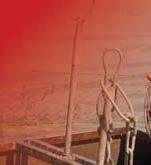

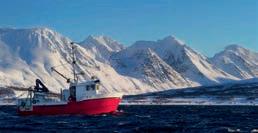
One of the keys to transparency in the global fisheries supply chain is data transparency. Norway has agreed to share their Vessel Monitoring System with the non-profit, Global Fishing Watch. Global Fishing Watch uses satellite tracking data to map commercial fishing vessels and fishing activity. The agreement with Norway will add the location of around 600 vessels to the Global Fishing Watch database. Accurate fishing vessel tracking is a necessary component in mitigating and minimizing illegal, unreported, and unregulated fishing. Norway’s agreement to share their vessel monitoring data with
GFW is a big step in documenting the environmental footprint of the fishing industry and offers the opportunity to establish worldwide data to understand the full scale of impact of the fishing industry. In addition to the agreement, Norway has expanded their vessel monitoring systems to include all commercial fishing vessels and has increased the frequency that vessels must report their location. The agreement has raised concerns as to why the EU has yet to cooperate and share their fishery data to the same extent. EU spokespeople have responded by identifying EU privacy regulations make contributing
the Global Fishing Watch difficult and highlighted the EU’s existing electronic logbook processes for all EU vessels. Regardless, this
agreement reminds all fishery professionals that reporting, and transparency can always be improved and increased.


The Spanish Fisheries Confederation (CEPESCA) has released its report on the Spanish fish sector for the 2020-2021 period. Total production value was 2,043 million euros which was a 10 growth from 2019. The report identified that Spain accounts for 28 of the total value of EU fishing. The Spanish fishing industry generated 31,093 direct jobs and 150,000 indirect jobs in 2020. There was an increase in imports and exports from 2020-2021. This growth reveals the resilience of the Spanish fishing sector in responding to the COVID-19 pandemic and maintaining successful health and safety measures on fishing vessels. The report recognizes Russia’s invasion of Ukraine as a new crisis for the industry to manage and identifies increased challenges resulting from new EU environmental policies, regulations, and objectives. These new policies include a potential reform of the Common Fisheries Policies and the Law on Sustainable Fisheries and Fisheries Research. The closure of
87 vulnerable marine zones from deep sea fishing will also have an unknown socio-economic
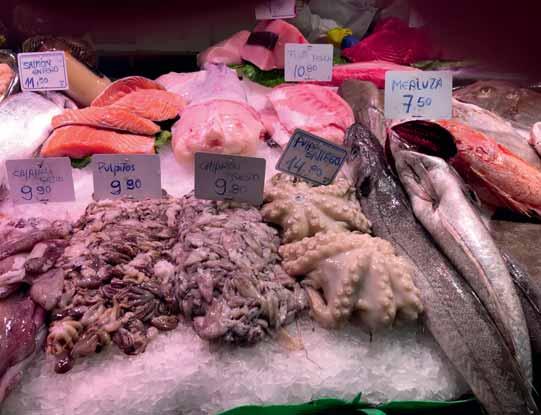
impact on the Spanish fishing industry. The report identified the importance of strong industry
leadership as increases in prices of fishing oil and diesel will make profitability more difficult.

Sea lice are one of the primary challenges in salmon aquaculture. Sea lice put fish health, the economic viability of the product, and wild salmon populations at risk. Monitoring sea lice in aquaculture facilities is a necessary but expensive measure for aquaculture companies. Researchers at NINA, the Norwegian Institute for Nature Research, and NTNU, the Norwegian University of Science and Technology, have developed an innovative new lice trap system for monitoring sea lice. Norwegian aquaculture operates on a “traffic light” system where the infection pressure from sea
lice on salmonids is monitored to determine if salmon production can be increased or needs to be decreased. The current system relies on significant statistical modeling as well as manual counts. This can be an expensive and time intensive processes. The new sea lice trap technology filters seawater but traps plankton which can be analysed in the lab using DNA based methods to calculate the number of sea lice larvae. In the current early development stages, results from this technology are being compared with results from current monitoring to calibrate the models
Sea lice are a major challenge for the salmon farming industry. A new lice trap technology will help monitor them.
and ensure accuracy. In the early stages of research and development, this method presents a
cost effective and easily scalable solution to monitoring sea lice levels.





A project consortium of six partners from five countries has developed an innovative device for safety training for crews on fishing vessels. The technology is a virtual reality simulator that educates fishermen on hazards and safety procedures, exposes them to hazardous scenarios, and walks them through the safety procedures and how to execute them. This is an important technology for the fishing industry because most fatal accidents that occur on fishing vessels are the result of a lack of knowledge of emergency procedure and how to
execute appropriate emergency procedure. Often, there is a general lack of compliance by crewmembers on periodic training and safety exercise requirements. This VR technology hopes to combat this issue to emphasise the importance of safety in fisheries. The technology was introduced by the European Parliament at an event hosted by MEP Gabriel Mato and EU fisheries experts. The event was attended by fisheries stakeholders, including representatives of EU Institutions, industry and civil society that saw the need for this innovative tool.



Octopus populations in Croatia have been affected by overfishing and hunting by recreational and professional fishermen. Octopus is primarily used for food in Croatia. As octopus stocks have decreased in recent years, they continue to be overfished as their perceived rarity has increased the product value. Researchers at the University of Split are now exploring the viability and potential for octopus restocking. This research has involved the release of hundreds of thousands of octopus larvae into the sea. The researchers will then track the
integration of the octopus into the ecosystem and the wild population. The hope is to develop optimal conditions for octopuses’ survival to help the populations rebound. Currently, only 1 of octopus survive the larval stage and increasing this percentage is imperative for successful restoration. To monitor the success of the released larvae, the scientists are manually tracking the octopus larvae using genetic samples, and they have asked fishermen to contribute to data collection by providing samples for DNA analysis when they catch an octopus.
The Hungarian fishing industry is poised to benefit from the EU’s recent protection of the Balaton fish brand in restaurants. The Balaton fish brand labels indigenous Hungarian fish that have been produced in Lake Balaton, a large freshwater lake in western Hungary. The protection of the Balaton fish label will help ensure

high quality, carefully controlled, and locally produced fish. This will benefit fishermen, restore the status of fish from Lake Balaton as a high-quality product, build awareness of indigenous and nonindigenous species among local people and tourists, and give gastronomic recognition to fish from Lake Balaton. This is an exciting

Hungary: Balaton fish brand will be available in Hungarian restaurants after receiving EU protection
milestone for a region that has historically struggled with overfishing and low fish stocks. It is estimated
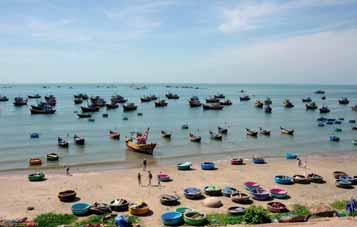
that 800,000 people work in the Hungarian fishing industry. Lake Balaton produces 500-600 tonnes
of wild, and 150-200 tonnes of farmed fish annually. If all goes well with the Balaton brand
implementation in restaurants, it will hopefully be integrated into the retail sector soon.

The EU funded project EcoScope aims to identify the key challenges facing the fishing industry and develop electronic and digital tools for mitigating the challenges. The goal is to help implement ecosystem-based fisheries management that can fine tune the accuracy of marine policy scenarios, spatial planning systems, and other models. This hopefully will help mitigate some of the human impacts and ecosystem degradation in European seas. The project began with a survey of fisheries industry
stakeholders to understand their needs, industry challenges, and the potential future obstacles. The survey revealed that 72.2 of respondents believe that global warming is a major threat to fisheries. Secondly, by-catch, increased protection areas, and fisheries restricted areas are the next biggest concern with 50 of respondents identifying each of those factors as a concern. Other notable risks were biodiversity reduction and marine and coastal area user conflicts, and species distribution.

The French and Spanish tropical tuna fleets are currently being undermined by EU margin of tolerance control rules. Stakeholders argue that the regulations that specify the degree of variability between catch estimates and actual catch landing that make it impossible for the tropical tuna fleets to be economically profitable. The regulation identifies that there must be a difference of no more than 10 per species between catch estimates on board and the landed catches. The issue with this regulation is that when the temperatures on the boat are high (above 30 degrees Celsius) the fishermen only have a few minutes to sort and freeze the catch before it becomes unsafe for human consumption. Tuna fisheries organizations argue that differentiating between different species in this short time frame is very difficult and leads to incorrect catch estimates. Consequently, the fleets receive heavy sanctions. Fleets from other countries face
less stringent regulation and therefore the Spanish and French fleets face disproportionate economic challenges. The tuna organizations request that the regulation
be modified so the 10 rule applies to the entire fleet rather than each species. Currently, the sanctions are so detrimental to the fleets than an independent economic analysis
found that if nothing changes by 2026, the ship owners will need to shut down. This would represent a loss of 1,600 French jobs and 2,500 Spanish jobs.
The EU Cohesion policy which allocates funds to support the social, economic, territorial cohesion, competitiveness, green and digital transition for EU countries has allocated 31.5 billion euros to Romania. Of this sum, 162.5 million will be from the European Maritime Fisheries and Aquaculture Fund to be invested in sustainable fisheries and aquaculture, conservation of aquatic biological resources in the Black Sea, fisheries control, sustainable aquaculture, processing, diversity in local fisheries and aquaculture communities, and in supporting modernisation of fishing infrastructure in the Black Sea. Commissioner for the
Environment, Oceans, and Fisheries, Virginijus Sinkevicius, stated that the Partnership Agreement will allow Romania to build innovative, low-carbon and sustainable fisheries, aquaculture and processing sectors while also reinforcing the economic and social vitality of coastal communities. It will also support the resilience of sectors faced with exceptional events that lead to serious disruption of markets.” This partnership should be valuable for the Romanian fisheries sector’s continued growth and will help mitigate economic challenges resulting from Covid-19, high fuel prices, supply chain disruptions, and Russia’s invasion of Ukraine.
In a year that has been rocked by inflation, salmon consumers are finally starting to see some price relief. After consistently high prices for the first half of 2022, salmon prices are beginning to fall. Salmon prices peaked in May of 2022 with a maximum price of EUR 10.57 per kg of fresh salmon. The prices stayed high for a large portion of June, however, the NASDAQ salmon index 12-week average indicates that there has been a 12 decline in prices with the price currently
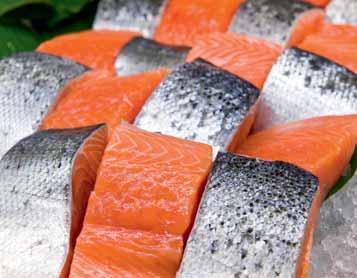
around EUR8.82 per kg of fresh salmon. Experts from FishPool, a marketplace for salmon financial contracts, predict that the price will fall to 8.69 EUR. This fall in prices would be in line with normal salmon price trends. Demand tends to decrease during the summer holiday while people travel while supply continuously increases. Annual price lows are typically seen in the second half of the year as the supply is consistently higher, but demand either decreases or is stagnant.
Salmon prices see their first decline in 2022.
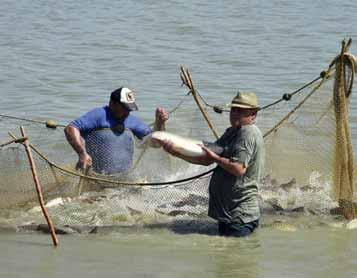
At the plenary on the EU’s biodiversity protection ambitions, the Croatian MEP Valter Flego requested that the EU pay more attention to the protection of the Adriatic Sea. He said that while soil, forests, and air protection remain at the forefront of EU biodiversity protection
ambitions, the sea seems overlooked. He emphasised that for people living in the Mediterranean and relying on the Mediterranean and Adriatic seas for food, recreation, tourism, and other uses, the sea was just as necessary to protect and maintain as the land or air. He

called for further discussion of the preservation of the sea at the COP 15 summit (the UN Biodiversity Conference). The management and protection of the Adriatic Sea is an important issue because the detrimental effects of climate change are rapidly beginning to
be seen. The sea is changing, and the water temperature is increasing which helps invasive species establish and kills native species. This puts a significant number of economic sources such as fisheries and tourism at risk for Croatia and other Mediterranean countries.
Fishmeal and fish oil (marine ingredients) are derived primarily from small pelagics including Peruvian anchoveta, menhaden, blue whiting, capelin, sardines, and herring although production from by-products is increasing and will continue to grow.
Global production of fishmeal and fish oil depends on catches of these species which vary with the state of the resource. Stock abundance is influenced by natural phenomena such as the El Niño— Southern Oscillation and tends to fluctuate. According to the 2022 edition of the FAO’s State of World Fisheries and Aquaculture (SOFIA), volumes of fish reduced to fishmeal and fish oil peaked in 1994 at 30m tonnes, declined to 14m tonnes in 2004, increased again to 20m tonnes in 2018, before falling back to 16m tonnes in 2020. Fishmeal and in particular fish oil are also derived from by-products from fish processing, a share that is increasing. Other sources of these two ingredients that are being explored include Antarctic krill and the copepod, Calanus finmarchicus, fish silage, a protein rich hydrolysate, and insect meals

The main use of fishmeal and fish oil is in aquafeeds for the aquaculture industry. About 86 of fishmeal and 73 of fish oil was designated for this purpose in 2020. However, as production from aquaculture has increased while fishmeal and fish oil output has remained within certain limits, the share of these ingredients
in aquafeed has been steadily declining. They are increasingly being used for specific stages of production (hatchery, broodstock, finishing diets) rather than in feeds for on-growing diets. As an example, the proportion of these ingredients in on-growing diets for salmon is now often less than 10, according to the FAO. To discuss these and other developments in the marine ingredients industry, Seafood Source, a part of Diversified Communications, organised a webinar on 31 August that was addressed by executives from the Marine
Ingredients Organisation (IFFO), an international trade organisation representing the global marine ingredients industry. The event was moderated by Cliff White from Seafood Source.
Marine ingredients are the most nutritious and most easily digestible components in aquafeeds. They are also the source of the healthful omega-3 fatty acids which benefit both the growing fish as well as the humans who consume the fish. The ingredients also have a multiplier effect with 1 kg of the raw material used
to produce fishmeal and fish oil resulting in 5 kg of farmed fish, according to Petter Johannessen, IFFO Director-General. Many of these fisheries are certified as sustainable. Of the average global production of marine ingredients in the years 2017-21, 49 was certified as sustainable up from 21 in the 2010-14 period. In addition to the omega-3 fatty acids, marine ingredients are also a source of other nutrients such as essential amino acids. Research shows that palatability of salmon aquafeeds increases with the addition of marine ingredients, while protein
digestibility for anchoveta meal is very high and shows little variability, in comparison with alternatives such as soy or corn gluten, reported Brett Glencross, IFFO Technical Director.
Explaining that sustainability was fundamental for the marine ingredients industry, Dr Glencross said that the maximum sustainable yield for a stock was the most common way of looking at sustainability. The MSY is the highest possible annual catch that can be sustained over time keeping the biomass at a level that produces the maximum growth of that biomass. Small pelagic fisheries are among the best managed in the world with their biomass being sustained at expected levels, he pointed out.
Among the reasons is the reduction in fishing pressure over the last couple of decades which has also contributed to a largely stable supply of marine ingredients over this period. The environmental footprint of small pelagic fisheries in terms of their greenhouse gas emissions per unit of landings is the lowest of all species groups (demersal, large pelagics, crustaceans, cephalopods etc.).
Emissions are most closely associated with fuel use during fishing operations. Similarly, the carbon footprint of marine ingredients compares very favourably with those of alternate ingredients.
In terms of their use of biotic resources, however, marine ingredients tend to consume more than other ingredients, though their use of abiotic resources is lower. This balance illustrated Dr Glencross’ contention that the perfect ingredient did not exist; there will always be a trade-off. He also referred to the fact that while
From bulk ingredients in fish feed, fishmeal and fish oil have gradually become strategic ingredients used in specific stages of aquaculture production. In on-growing diets for salmon, for example, the proportion of marine ingredients today is often less than 10%.
most fish caught and farmed is for human consumption less than half is actually eaten. The other half can be recovered and returned to the food chain by using it to produce marine ingredients. Moreover, some species, such as Atlantic mackerel, previously used for reduction to fishmeal and fish oil are now being used almost entirely for human consumption. But these too generate by-products that can be used to produce marine ingredients.
Enrico Bachis, IFFO Market Research Director, confirmed much of what had been said by the previous two speakers but added more detail. The contribution from by-products is increasing, particularly in the case of fish oil, where by-products now amount to a third of the raw material. In the case of fishmeal this fraction is about 15. These byproducts come from both capture fisheries and the aquaculture industry, and their contribution is likely to increase in the future as
the production from aquaculture grows and techniques evolve that allow more of this material to be recycled. The biggest suppliers of marine ingredients in geographical terms are Latin America, Asia, and Europe with Latin America supplying between a quarter and a fifth of the total. In Asia and Europe, the raw material is a mix of wild catches and by-products from aquaculture, while in Latin America the raw material is mainly from wild fisheries. The data for fish oil includes the menhaden fishery in the US which accounts for 12 of the raw material thanks to the species’ high content of fish oil. Average fishmeal and fish oil production over the last nine years was about 5m tonnes and 1.2m tonnes respectively per annum. This stable supply can be attributed to the generally well managed fisheries on which this supply is based. Fluctuations from year to year have been due to natural events such as El Niño, said Dr Bachis, rather than overfishing.
The structure of demand for fishmeal and fish oil has changed over the decades with aquafeeds replacing poultry, pig, and pet feeds as the biggest consumer. The
fraction of fish oil for direct human consumption in the form of products for human health has also increased and in 2020 accounted for some 12 of the total. However, as production from aquaculture has grown and marine ingredients production has remained stable, fishmeal and fish oil have evolved from bulk ingredients in aquafeeds to strategic ones. In closing Dr Bachis showed that crustaceans are the biggest users of fishmeal followed by freshwater fish, marine fish and salmonids. The sheer volume of crustaceans (11.2m tonnes) and freshwater fish (48m tonnes) produced around the globe are responsible for their position ahead of salmonids (4m tonnes) in usage of fishmeal. On the other hand, salmonids are the biggest consumers of fish oil followed by crustaceans and other marine fish. More generally, the crustacean and specifically the shrimp sector is a growing and not just in Asia but also in Central and Latin America. Since production of marine ingredients is stable, farmed species showing strong growth will tend to push out others in the quest for these ingredients. The competition for marine ingredients looks set to increase.

From its initial application in 2009 to the Intergovernmental Conference on accession negotiations earlier this year, Albania has come a long way in its endeavours to join the EU. Frida Krifca, Minister of Agriculture and Rural Development, discusses here issues facing Albania’s fisheries and aquaculture sector including the task of aligning national legislation with the EU acquis.
Albania is implementing the provisions of the Stabilisation and Association Agreement as a step towards EU membership. In its status report for 2021 the European Commission points to the lack of sufficient staff in inspection and control. What are the reasons for this and has the situation been remedied? What parts of the CFP remain to be adopted into Albanian legislation?
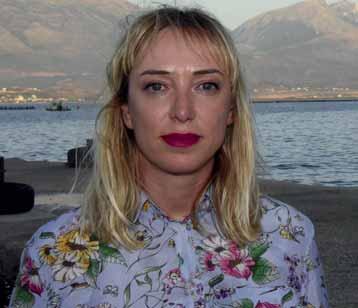
Albania has taken measures to increase the capacities of the fisheries inspectorate. New staff have been recruited, increasing the number of fishing inspectors and guaranteeing 24/7 control at the four fisheries ports. Also, in the framework of the IPA 2016 Project “Fishing Blue - Support for the fisheries sector in Albania” which is financed by the EU, training sessions were conducted for staff of the fisheries inspectorate with the aim of increasing the capacities of this inspectorate. Likewise, at sea and on land control manuals for the fisheries inspectorate have been prepared and distributed, and all fisheries legislation has been published for fishing operators and the fisheries inspectorate. Within the framework of this project, 11 fisheries inspectors have been trained and certified as national observers for all activities related to tuna fishing, according to ICCAT requirements. In September 2022, the fisheries inspectorate will be
equipped with 2 control vessels, donated from the EU, which will provide a great help in increasing the control of fishing activity
Albania has opened negotiations with the EU for membership. This is a long process which will require a great deal of work for the fisheries administration and the transformation of the sector to align with EU standards. Albanian legislation is generally in line with the EU acquis, but a lot of work is required for the whole sector to be made compliant with the Common Fisheries Policy. Recently, the new fishing strategy was approved, within the framework of the Strategy for Agriculture, Rural Development and Fishing 2021-2027, with the support of GIZ, which prepares the fisheries sector and brings it closer to the EU.
VMS is used to monitor the activities of the Albanian fishing fleet while fisheries inspectors control the smaller vessels. This year (2022) electronic logbooks are scheduled to be introduced to increase the transparency of fishing activities. While these measures benefit managers and policy makers, what has been the response of the fishermen?
The ERS system, the electronic logbook, is planned to be implemented in 2024. During 2022, the legal foundation will be prepared, in
accordance with EU legislation, and during 2023, TORs for its establishment will be prepared and the tendering procedures will be carried out. The implementation of this system is expected to increase the transparency of fishing activities. There will be a long process of consultations with interest groups, but the process of joining the EU requires an increase in fishing standards as well. The interest groups are aware of the necessity of its implementation and the process is advancing as MARD (Ministry of Agriculture and Rural Development) has planned.
Albania is a signatory to the 2018 ministerial declaration
on a regional plan of action for small scale fisheries (SSF) in the Mediterranean and the Black Sea. The plan envisages several actions1 in relation to data collection, scientific research, SSF management, climate change adaptation, sustainability etc. over the 10 years to 2028. Which actions are being given priority by the ministry? How does the ministry encourage the organisation of the SSF?
Small Scale Fisheries are an important component of Albanian 1 https://www.fao.org/3/cb7838en/ cb7838en.pdf
fisheries and as such receive special attention from MARD. The ministry improved the fishing law by approximating a part of Regulation (EU) no. 1379/2013, of the European Parliament and of the Council, dated December 11, 2013, “On the common organization of markets for fishery and aquaculture products”. Measures have been taken to improve the technical rules concerning the sector‘s development, and a support package is being prepared to regularise informal operations in the sector.
What has been the impact of the corona virus on the Albanian fisheries and aquaculture sector? What measures were implemented by the government to assist the sector? Would you say that activity has returned to its pre-pandemic level?
The impact of the coronavirus was primarily felt in the decrease in demand as a result of the closure of part of the country‘s markets that consume fish products. The processing industry also saw a reduction in activity despite the growing demand for processed products both on the domestic and international markets. However, despite this, there was an increase in exports of Albanian products in 2020 and 2021 although not at the level of previous years.
Another issue is the impact of the war in Ukraine, which has brought about an increase in the price of fuel for fishing. The first six months of 2022 was a difficult period for marine fisheries, which saw a reduction in fishing activity. To assist fishers with this situation, MARD decided to support the sector by subsidising fishing fuel with 40 lek/litre. This support will be implemented in the second half of 2022 and will compensate some of the additional costs arising from the price increase.
What is the status of the fish auction at Shengjin? Has it contributed to greater transparency in pricing, the removal of middlemen, and better prices for the fishers? Does it facilitate the distribution and sale of fish and seafood products? The new wholesale market at Vlora is scheduled to open this year. What has been the response from fishers and seafood traders to these new structures?
Wholesale fish markets are a priority for MARD. The Shengjin wholesale fish market is in the final stages of being transferred to Lezha Municipality as duties and responsibilities are defined and assigned. The wholesale fish market in Vlora is completed and the fisheries management organization (FMO) in Vlora has applied to manage it. MARD is in dialogue with the FMO to determine the conditions, duties, and responsibilities, related to the transfer of this structure.
Producer organisations (POs) are an integral feature of the Common Market Organisation one of the pillars of the Common Fisheries Policy. POs organise fishers and farmers to jointly pursue objectives listed in the CMO regulation including sustainability, food security, and growth and employment. Do you see this as a useful instrument for the Albanian fisheries and aquaculture sector? Is the legal framework for the creation of POs in place?
As mentioned above, the amendments to law no. 64/2012 “On fisheries” as well as the changes in the law no. 103/2016 “On Aquaculture” as a partial approximation of Regulation (EU) no. 1379/2013, of the European Parliament and of the Council, dated December 11, 2013, “On
the common organization of markets for fishery and aquaculture products” establishes the basic rules for the creation and recognition of Producer Organizations, as an important instrument for the regulation of the sector. Also, the conditions that these organizations must fulfil to be recognized by MARD have been defined and approved. Minister‘s Order no. 357, dated 29.7.2022 “On the adoption of the regulation on the determination of additional conditions for the recognition of production organizations” has been approved.
Fisheries management organisations have been established to manage freshwater resources in several Albanian lakes. How do you assess their usefulness and reliability as partners of the administration in questions of fisheries management. Has the delegation of responsibility to the FMOs resulted in improved stock status, less illegal fishing, and stable catches?
Fisheries management organisations in Albania were created as an important management instrument where interest groups played the main role. FMOs extend to inland and marine waters. MARD has given the management of the fishing port of Durres to FMO-Durres and is in the process of transferring the wholesale fish market of Vlora to FMO-Vlora. FMOs contribute to the management of the sector through co-management, where the ministry delegates powers related to the management of the fishing activity. Regardless of whether the fishing law provides for forms of organization such as FMOs or Producer Organizations, we are of the opinion that FMOs will gradually transform into OPs covering the entire production
chain, from the factory to the final consumer.
A World Bank report2 suggests that the yield from capture fisheries is unlikely to increase very much over time and the future for Albanian seafood production lies in the aquaculture sector. Do you agree with this assessment? What measures are being implemented to boost aquaculture production in Albania? Have allocated zones for aquaculture (AZA) been identified and legally implemented?
We agree with the assessment of the World Bank. The increase in demand for fish products, not only in Albania but also at the global level, will be fulfilled through the increase in production from aquaculture. Global assessments predict that demand for fish products will double by 2030. Today, in the Mediterranean the situation of fish stocks is not good with about 85 of the commercial species overfished. Even at the global level, capture fishing industries are in decline, compared to aquaculture, which continues to show substantial growth. MARD has prepared a study for Allocated Zones for Aquaculture (AZA) in the sea and so far one of them has been approved, and others are in the process of negotiation with the Ministry of Tourism and Environment. In addition, this year MARD is funding a study on AZA in internal waters which will be carried out by the Agricultural University of Tirana with the technical assistance of the General Fisheries Commission for the Mediterranean.
2 https://openknowledge. worldbank.org/bitstream/ handle/10986/34892/ Realizing-theBlue-Economy-Potential-in-Albania. pdf?sequence=1&isAllowed=y
The fisheries and aquaculture sector in Albania
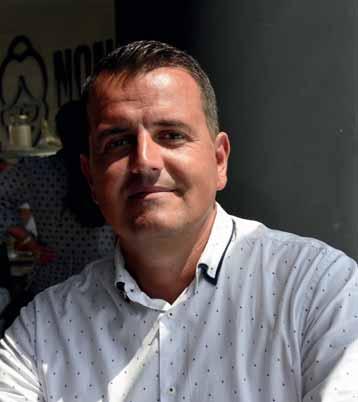
Global warming and climate change are increasingly affecting fisheries and
and while they may bring some advantages, they also create conditions to which farmers and fishers must adapt.
Capture fisheries in Albania from the sea, along the coast, from inland waters, and coastal lagoons have remained largely stable over the five years to 2021, according to data from Institute of Statistics. Marine catches include some 45 species of fish, shellfish, and cephalopods and averaged about 6,000 tonnes over the five years to 2021.
About a third of the catches can be attributed to just two species, European anchovy and deepwater rose shrimp. Catches of hake and pilchard are also significant while volumes of the remaining forty species are small. Catches along the coastline and in the coastal lagoons also contribute modestly to the Albanian capture fisheries. Inland waters yielded some 3,000 tonnes of fish per year on average over the same period, of which the proportion of carps (common, crucian, silver, bighead etc.) was close to 55. Total yields showed a slight increasing trend over the period. Roaches, mullets, and perch were the other inland water species caught in significant volumes.
The Albanian fleet comprises trawlers, seiners, dredgers, gillnetters, and multipurpose
of which the gillnetters and trawlers dominate the fleet in terms of numbers. In contrast to most EU fleets the number of vessels has been increasing in Albania. Between 2017 and 2021 the fleet increased by over a third to 750 vessels thanks mainly to a 45 increase in the number of gillnetters to 525 vessels. The trawler fleet also increased from 157 to just under 200 vessels. The large-scale fleet (LSF) comprising vessels above 12 m fishes outside the 3 nautical mile limit targeting hake, shrimp, and red mullet. The demersal and pelagic fisheries for sardines and anchovy are managed with temporal restrictions. Two years ago, large vessels were equipped with vessel monitoring system (VMS) equipment so they can be monitored by fisheries inspectors. The individual species with the highest catches in 2021 were anchovy and deep-water rose shrimp
Fish
which accounted for about a fifth and 16 of the total respectively.
Anchovy catches fluctuated violently in the five years to 2021 from 1,500 tonnes in 2018 to 260 tonnes in 2020. Other important species in terms of catch weight were hake and pilchards. The total catch in 2021 was 6,300 tonnes. Fishers have also noticed the presence of species, both native and alien, not normally found in the areas being fished. In a survey conducted among small scale and recreational fishers by staff at the department of aquaculture and fisheries under the FAO Adriamed Project, respondents mentioned 75 species. Their presence could be explained by global warming and the data from the survey might help local communities better understand, manage, and adapt to the ongoing biotic transformations driven by climate change, says Dr Jerina Kolitari from the Aquaculture and Fishery Laboratory in Durrës. Climate change
is not the only issue that fishers and fisheries managers have to contend with. Another is marine pollution which takes the form, among others, of microplastics and ghost gear. Through the laboratory in Durrës, Albania has participated in projects, such as DeFishGear, that aim to quantify and reduce the amount of marine litter in the sea and on beaches.
The small-scale fleet (SSF) fishes within the 3 nautical mile limit and can be controlled when the fishers land their catch as well as at sea where the inspectors check the net dimensions, dimensions of the caught fish, the licenses, and the distance from the shore.
Administrative measures taken against vessels found in breach of the regulations has created an awareness of the need to maintain the permitted depth and the
correct distance from the coast and have prevented some illegal fishing, according to Dr Kolitari.
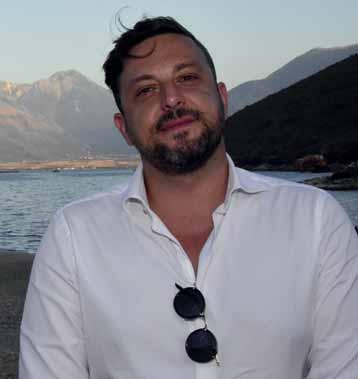
These measures are intended also to address the paucity of data on the SSF. In an article1 in the Croatian Journal of Fisheries, Prof. Rigers Bakiu, Head of the Department of Aquaculture and Fisheries, Faculty of Agriculture and Environment, Agricultural University of Tirana, and his co-authors show that the SSF in the Mediterranean uses many different gears, are active in different seasons and on different fishing grounds and target a variety of species. The Albanian SSF is responsible for about 5 of the total fisheries catch though over 60 of the number of vessels and 28 of the total employment in the fisheries sector. In their study which centred around vessels operating in southern Albania, the scientists established that essentially two types of gear, nets and longlines, were deployed by the fishers. With the former, fishers target hake, mullet, cuttlefish, and sole,
while with the latter fishers target either the large pelagics like bluefin tuna and swordfish or seabreams, porgies, and groupers. The objective of the study was to generate data on the SSF, which are otherwise data deficient, and to use this information to create a clearer picture of the status of marine fisheries and thereby allow more reliable stock assessments. The authors also recommended “robust monitoring mechanisms and multiple control protocols” to reduce data uncertainty.
Production from aquaculture has doubled from 4,000 tonnes in 2017 to 8,100 tonnes in 2021. The main species farmed in Albania are the marine species, seabass and seabream, as well as the freshwater species, rainbow trout. In addition, several carp species are farmed in polyculture with other freshwater species. Natural and artificial lakes, and reservoirs are used to cultivate
horse
these fish and farmers use intensive, semi-intensive, and extensive fish farming techniques.
Finally, there is a cultivation of mussels at a couple of sites, one in the north of the country in the bay of Shengjin and the other in the Butrinti lagoon in the south.
The main growth in the aquaculture sector comes from the production of seabass and seabream and of rainbow trout where companies from Italy and Turkey have invested in facilities in Albania.
Reflecting the growth in production is a steep rise in the number of people employed in the sector which has gone from 2,800 in 2012-13 to 9,600 in 2021, says Frida Krifca, Minister of Agriculture and Rural Development. Now, however, in common with the sector in other parts of Europe, it is becoming more difficult to fill positions and farmers are starting to grumble about the lack of
qualified labour. The lack of interest in fish farming could perhaps be attributed to the work itself which is physically demanding and the salaries that go with it.
Young people would rather be working at a desk in a comfortable environment rather than be mucking around on a fish farm.

The shortfall in labour is one of the challenges facing the sector.
Another is the implementation of allocated zones for aquaculture (AZA). According to the General Fisheries Commission for the Mediterranean (GFCM), AZA are areas earmarked for the development of aquaculture, an activity which, within the zone, has priority over other uses. The identification and implementation of AZA
is a priority for the sustainable development of aquaculture in the Mediterranean at a time when pressure from different interests on coastal zones are proving a bottleneck for the development of the aquaculture sector. AZA are expected to facilitate the integration of aquaculture into plans for coastal development and lead to improved coordination between the various authorities and other stakeholders in the area. In Albania the study to identify the AZA has been completed, says Arian Palluqi, Director, Ministry of Agriculture and Rural Development, and sea cages have to be moved 300 m away from the coast. The study was carried out by an Italian consultancy working in close collaboration with the ministry. Areas have been identified in Saranda and in Shengjin and for the cultivation of fish and of shellfish. The government has to approve the map of the different AZA which take into account the interests of the environment and the tourism sector. Although fish farming and tourism tend to compete for the same space, they also have common interests, Ms Krifca points out. For farmers tourists are a ready market for the fish they produce, while for tourists fish farms are not only a source of healthful and very fresh protein, but could also be
an attraction to visit and learn about fish farming. Mr Palluqi is hopeful that the approval will be forthcoming later this year or early in 2023.
A long-term challenge to the aquaculture industry is the impact of global warming which is affecting both freshwater and marine production. Warming water, extreme weather events, a shortage of precipitation, the increased presence of invasive species, and algal blooms can be attributed to global warming. Other impacts include a reduction in the oxygen content of the water, and an increase in acidity as the water absorbs more carbon dioxide due to the increase in atmospheric concentrations of the gas. The FAO has identified the Mediterranean as a region where droughts are likely to be longer and more frequent, a development which is likely to affect the aquaculture sector. And while oceans are warming around the world, it is in the northern hemisphere that this is most obvious, reports the organisation. In Albania, trout farmers experience that as the water warms up the fish move deeper down the water column and if the surface gets too warm they are reluctant to even come
up to feed. For mussel farmers too increasing water temperatures can have an impact on the production as the Mediterranean mussel can tolerate temperatures of up to about 23 degrees centigrade. If it gets any warmer they will start to perish, says Tonin Suli who farms mussels in the Shengjin bay. For fish grown at sites where the water is deep the animals can avoid the higher temperatures at the surface by migrating to cooler depths. Mussels too could be suspended from ropes that extend deeper into the water column. While these adaptations may be feasible at some sites it may not be an option in shallower waters or where higher temperatures have caused water levels to drop. Farmer using
such sites will therefore have to devise other solutions.
Warming does not affect all species equally. Prof. Bakiu says that European seabass is more affected than gilthead seabream, the two main marine species farmed in Albania. Farmers are increasingly producing seabream exclusively as it can better tolerate the increase in temperature and the heatwaves that cause oxygen levels in the water to fall. Moreover, seabass seems to be more vulnerable to the diseases related to the changing temperature, he
notes. In a paper2 in the Albanian Journal of Agricultural Science from 2021 Prof. Bakiu and a colleague looked at the impact of climate change on the abundance and catch of seabass and seabream in Albanian water and stated that temperature and salinity have significant effects on growth and feed intake of juvenile seabass. The species showed a preference for lower temperatures in comparison to seabream which thrived at higher temperatures. This suggests that seabream could become more abundant than seabass in Albanian waters as the temperature increases.
Invasive species that establish themselves in response to warming can also be a threat to the aquaculture industry. Prof. Bakiu mentions the pumpkinseed fish (Lepomis gibbosus) that has invaded the Dumrea lakes near Elbasan and feeds on the larvae and fingerlings of the carp species, common carp, bighead carp, grass carp etc., that farmers are cultivating in the lakes. Sudden extreme heat can also lead to a rapid drop in the oxygen content of the water which can cause mass fish deaths. Fish farmers are trying to adapt by reducing the biomass they hold to facilitate the management of the production, says Prof. Bakiu. He, together with colleagues from the department of aquaculture and fisheries at the university, is conducting a survey of freshwater fish farmers to understand their situation and the threats and challenges they face. The survey will also identify and help to regularise
operators who may be behind on their paperwork. This will allow the government to channel aid to the farmers with which they can invest in aerators or oxygen as a way of adapting to climate change.
Climate change also has an impact on the fishing sector. For fishers too one of the threats from warming water comes from the migration of non-native species to Albanian waters in the Ionian Sea. Prof. Bakiu reported the presence of a lionfish (Pterois miles) in June last year. Recorded for the first time in Albanian waters the species is native to the Red Sea and the Persian Gulf. It has colonised Greek waters where it is reputed to be a threat to commercially important or critically endangered species, according to a paper in a book3 Lionfish Invasion and its Management in the Mediterranean Sea published by the Turkish Marine Research Foundation. According to Prof. Bakiu it feeds on larvae as well as juveniles of species native to Albanian waters and although it is a valuable species for fishers and charismatic for divers, it needs to be treated with care as its spines are poisonous. He expects it to establish a population in Albanian waters in the next 2-3 years as it moves from the south of the country to the north.
The challenges presented by climate change are only likely to increase in the future. The way towards safeguarding fisheries and increasing resilience is by the effective and sustainable management of resources. Albania has embarked on this path and is making progress towards these objectives.

Kilic’s Albanian subsidiary draws on the knowledge, training, and experience of the parent company in Turkey to farm rainbow trout in a dam lake.

Freshwater fish production in Albania comprises both capture fisheries from lakes and rivers as well as fish farmed in earthen ponds, raceways, and dam lakes. While there is significant overlap between the species from capture and those from aquaculture, one variety stands apart. This is rainbow trout (Oncorhynchus mykiss) which is farmed in raceways and more recently also in cages in dam lakes.
Probably the biggest producer of rainbow trout in Albania is the company Kilic Albania Aquaculture which was established in 2015. Kilic, a Turkish company, is a giant in the Turkish fish farming industry producing seabass, seabream, trout, meagre, and tuna. The company is fully integrated with hatcheries, nurseries, on-growing, processing, packaging, and distribution. It also manufactures its own feed. Kilic Albania Aquaculture is a fully owned subsidiary of the Turkish company and Saimir Todi, its chief of financial and administrative affairs, an Albanian, speaks fluent Turkish (and English).
The company has a hatchery where the larvae are produced. The trout eggs are imported from Poland, Denmark, Italy, or from Turkey and are placed in
incubators in the hatchery. Each month we need to buy 1 to 1.5m eggs, says Mr Todi to be able to harvest the quantities of marketsized fish that we need through the year. This number also takes into account a mortality rate of about 20 through the production cycle. The main suppliers are Poland and Turkey but irrespective of where the eggs come from, they are certified disease free and all female. If sourced in Turkey the eggs are flown from Adana to Tirana via Istanbul and are then transported by truck to the hatchery in Shkodra. Polystyrene boxes in which the temperature is kept at a constant level of about 5 degrees during the journey are used to store the eggs. Once they arrive at the hatchery they are removed from the boxes and adapted to the temperature of
the water in the hatchery, which is some 7 or 8 degrees. Moving directly from one to the other without adaptation would give the eggs an unnecessary shock.
The hatchery is supplied with water from a spring located 100 m away and which delivers a steady volume of water at a constant 12-13 degrees throughout the year.
The combination of water from a spring, the use of disease-free eggs, and the lack of other trout farms in the area means that the threat of disease is fairly remote.
The water temperature is a fraction higher than the 10-12 degrees that is considered the ideal temperature for a hatchery but is perfectly adequate for the purpose.
Once adapted the eggs are placed in the incubators where they typically hatch after a week. However,
the larvae continue in the incubators for another week before they are moved to large rectangular tanks where they spend the next one month before being transferred to the nursery section. The entire production process is carefully planned so that each stage of the production (incubator, larval tanks, post-larval tanks, nursery, grow-out) is completed in time for the next batch, a cycle which continues all year long, says Ali Gungorer, the hatchery manager. Altogether the time taken from the arrival of the eggs to the production of market sized fish of 300-350 g is 7-8 months. In the post-larval tanks the fish grow another month before being moved to the nursery for two months and thence to the cage farm when they weigh about 3 g. Irrespective of the source of the
eggs the quality of the fish is the same. As Mr Todi explains, if a difference was noted then the company would stop buying eggs from that supplier. The company also maintains a few broodstock fish from which is produced a small number of eggs. But we cannot do everything by ourselves, says Mr Todi, and expect to be very good at each activity. We have chosen to specialise in the production of fish rather than eggs. Besides, the eggs from Turkey come from the Kilic trout hatchery in Kahramanmara , where Kilic Turkey has its trout production.

The young fish are fed with different starter feeds depending on their size. Most of the feed comes from the Kilic feed production in Turkey, but the starter feeds are bought in Germany from a reputed supplier. Turkish foreign direct investment in Albania was the sixth largest in 2021 according to a paper in the European Journal of Business and Management Research1. For the parent company in Turkey the decision to invest in
Albania was influenced partly by the country’s proximity to the EU market and partly by the advantages gained from the lower cost of labour. The value of the investment by the parent company was EUR67m in total. The entire production from the trout farm is exported— the main destination is Poland with some fish also going to Romania. The product is exported fresh and frozen with most of the fresh fish going to Romania, and most of the frozen to Poland. The fish is processed at a facility in Durres with whom the farm has a contract. The fish is transferred to the processing plant where it is cleaned, gutted, and frozen when the order is for frozen fish or packaged in polystyrene boxes on ice when the demand is for the fresh product. For the time being the company has no plans to establish its own processing facility, says Mr Todi, as the system of contract processing works smoothly. But if the production volume increases, then we will consider setting up our own facility, he adds.
The dam lake in which the fish are on-grown is the lowest of three dam lakes in a row and Kilic Albania is the sole producer in that lake. The lake was created in
the 60s under the former regime and is reputed to have submerged several villages, the remains of which can be discerned at the bottom of the lake. The grow-out site is located some 14 km from the hatchery and holds 80 cages each with a diameter of 20 m and a depth of 10 m. According to MrTodi, this is the only farm of its kind in Albania; the other trout production facilities grow their fish in raceways or ponds. There is however a major challenge for the sector in Albania and this is the imposition of an 8.4 levy on the fish when it enters the EU. This obviously makes it very difficult for producers over here to make the margins necessary to invest in the business, Mr Todi states. Another factor that affects production is the fluctuating temperature of the water which can probably be attributed to global warming. There are sudden and sharp increases and decreases in water temperature and Caner Tasel, the farm manager, tries to compensate by keeping the cages full when the water temperature is appropriate and by
keeping fewer and fewer fish in the cages in summer, as the water gets hotter. Thus, from winter to summer the volume of fish in the cage falls from 20 tonnes to 10 tonnes. These adjustments are made without interrupting the production cycle, which must be maintained throughout the year as it determines the supply to the clients. When a cage is ready to be harvested it is towed slowly to the landing stage, where the farm’s vessels are docked, and anchored there. The cage is harvested at night when it is a more comfortable temperature for workers and fish alike and because the fish need to arrive early in the morning at the processing factory in Durres which is two and a half hours away by road.

The Albanian operation is closely monitored from Turkey. The farm
1 DOI: http://dx.doi.org/10.24018/ ejbmr.2022.7.4.1542
The eggs are acclimatised to the water temperature in the hatchery and placed in incubators where they stay for a couple of weeks.
is managed using special software that monitors all the parameters and generates reports, says Mr Tasel. Managers at the Turkey office can also log on to the system and see the status of the farm for themselves. Moreover, the general director for trout farming in Kilic Turkey spends a week each month in Albania making sure that everything is running smoothly. Saimir Todi himself spends 1-2 days a week at the farm in Shkodra and the rest of the time at the office in Tirana. The facility in Albania is responsible purely for production, processing, and packaging; all the sales and marketing for the fish is done by the office in Turkey, which is responsible for all the
customer contact and follow up. The model whereby responsibility is divided between the two entities
in Albania and in Turkey has been shown to work and is likely to continue for the foreseeable future.
Rruga Haxhi Hysen Dalliu Pallat. Alva Const. Shk. Sek. A Kati. 2, Ap. 4 Tirana Albania
Financial and Administrative Affairs Chief: Saimir Todi +355 69 8722885 saimirtodi@kilicdeniz.com.tr
Hatchery manager: Ali Gungorer Farm manager: Caner Tasel
Volume: 1,500 t per year

Product: Rainbow trout, 300-350 g
Product form: fresh and frozen Markets: EU (primarily Poland and Romania), small quantities to Serbia and Macedonia
Employees: 40 people of which the engineers and divers are from Turkey
Project knits Western Balkan countries closer to each other and to the EU
A project funded by the EU combines the objectives of improving higher education and promoting collaboration between countries to manage non-native species.
The project “Educational Capacity Strengthening for Risk Management of Nonnative Aquatic Species in the Western Balkans (Albania, Bosnia and Herzegovina, and Montenegro)—RiskMan” is an ERASMUS+ KA2 Capacity Building in Higher Education joint project, selected within the 2020— EAC/ A02/2019 call, and runs between November 2020 and November 2022. The project is coordinated by Mu la Sıtkı Koçman University, Turkey (http://www.riskman.mu.edu.tr/en/). Besides partner countries from the Western Balkans, the project consortium includes the programme

countries: Croatia, Greece, Italy, and North Macedonia.
Educational institutions cooperate with fisheries and aquaculture workers in fight against NNS
The project aims to promote the education of stakeholders, modernise higher education (HE), and stimulate research and cooperation in the risk management of non-native species (NNS). The project has the following specific objectives: (i) to harmonise the HE system on management of aquatic NNS in the Western Balkan partner
Representatives from the RiskMan project consortium at one of the stops on the Balkan tour. The project intends to strengthen educational capacity in the field of risk management of non-native species.
countries with the international directives given by FAO and IUCN and with the strategies of European Policy Cooperation; (ii) to support the partner countries in addressing the challenges that face their HE institutions and systems concerning the management of NNS, including risk identification, stakeholder participation, planning, and governance of aquaculture facilities and related fishery industries; (iii) to promote communication and awareness of stakeholders (students, workers in aquaculture and tourism sectors, and fishers) about the threat that NNS pose to biodiversity; (iv) to promote voluntary convergence with EU developments in HE and fisheries industry and contribute to cooperation among the consortium partners on the management of NNS; (v) to develop a risk management model for aquatic NNS in the Western Balkans; and (vi) to produce a policy framework for creating new occupations through the proposal of a new position “Risk Manager”.
To reach these objectives and prevent further introduction and spread of NNS in the partner countries, HE institutions and workers from the private sector related to fishery and aquatic ecosystem conservation were involved in the project’s activities.
Stakeholder involvement in creating a common language and providing the necessary structure for every stakeholder to work in the same direction are essential components of this project. Implementing new measures to manage aquatic NNS effectively requires strengthening the partners’ capacities. The added value of this project is the development of a protocol to explore the adaptation processes of socio-ecological systems in contrasting geographical settings, rivers, lakes, and coastal areas.
21 to 28 August 2022. The objectives of the tour were to draft the strategic implementation of the NNS courses in the partner countries, strengthen the established cooperation with stakeholders, and exchange experiences between the partner countries. The first stop on the RiskMan Balkan tour was in the ancient city of Kotor, organised by the Institute of Marine Biology, University of Montenegro. Strategies to introduce the new HE courses and curricula related to NNS in aquatic ecosystems were discussed. Several meetings were organised with local stakeholders, represented by marine aquaculture farmers (mussel and fish farms) and a seafood distribution centre.
equipment that would improve the didactics and provide particular skills for future professionals studying at AUT. The last stop was in Ohrid city, situated on the Ohrid lake, one of the richest European ecosystems in endemic species. Several meetings regarding protected areas and their management were organised by the Hydrological Institute Ohrid and the National Park Gali ica. The Gulf of Bones was chosen as a site for the meetings with stakeholders and dissemination activities. RiskMan partners presented the NNS and invasive species in Ohrid lake and the risks and impacts they could bring.
In the framework of this project, a Balkan tour was organised from
In Tirana, the Agricultural University of Tirana (AUT) and the Albanian Centre for Environmental Protection and Sustainable Development (ACEPSD) hosted the second part of the tour, where future plans for collaboration and joint projects, not only related to NNS, were discussed. As in Kotor, the tour participants had a chance to see the newly obtained
Mussel company owner looks forward to being able to export to the EU
In addition, the RiskMan Balkan tour has spawned a network of lifelong colleagues that will ensure the sustainability of the RiskMan project and form the basis for new initiatives in the future.
Prof. Rigers Bakiu, Head of the Department of Aquaculture and Fisheries, Faculty of Agriculture and Environment, Agricultural University of Tirana
Mussels from the Shengjin bay in Albania are grown on ropes for about 12 months before they are harvested and sold on the domestic market. One company, Lissus Adria, dominates the production which is marketed fresh in nets.
The aquaculture sector in Albania includes cultivation in the sea as well as in freshwater. Seabass and seabream are the main finfish species grown in marine water, while rainbow trout dominates the production in freshwater. In
addition, a few companies are producing mussels (Mytilus galloprovincialis) in the Butrinti lagoon in the south of the country while another, Lissus Adria, is farming them on lines in the Adriatic Sea off the coast of Shengjin, a city in the north.
According to Instat, the national statistical institute, mussel production in Albania has fluctuated significantly over the five years
to 2021 peaking at 1,100 tonnes in 2018 and falling back to 600 tonnes in 2021. Tonin Suli, a director and shareholder in Lissus Adria, is responsible for the mussel production. The bivalves are native to the area and are grown on ropes suspended from lines as
Roadshow to different countries strengthens links between partners
Tonin Suli, the director of Lissus Adria, a company that farms Mediterranean mussels on lines in the Shengjin bay.
is typical on the other side of the Adriatic, in Italy. The company has licensed an area of 76 ha for its mussel cultivating activities and is currently the only mussel farming company in the bay.
The mussels are collected and sold exclusively on the domestic market as their export to the EU is banned. Mussels can harbour toxins which they filter from the water in which they grow. These can become concentrated in the flesh of the mussel and pose a risk to consumer health. The level of the toxins is influenced
by several factors including the time of the year and therefore must be monitored continuously.
According to Mr Suli, tests to control the presence of harmful bacteria in mussels have consistently given good results with bacterial contamination measured at below 230 cfu (colony forming units)/100 g of mussel meat. This allows the water to be classified as Class A meaning mussels from here can be sold for direct human consumption without the need for depuration. But, Mr Suli says, the European Commission’s Directorate for Health and Food
Safety has to visit the country and report on the water quality at the mussel farming sites in Shingjin and in the Butrinti lagoon and only after that can restrictions on exports be reconsidered.
Mussels are a good source of proteins with a high content of essential amino acids; essential fatty acids including the wellknown omega-3 polyunsaturated fatty acids; vitamins; and minerals. They are low in calories, very tasty, and easy to prepare in different ways. Their nutritional content varies with the season in which they are harvested, for example, the protein content is highest in spring, but in general they are highly nutritious and good to eat around the year.
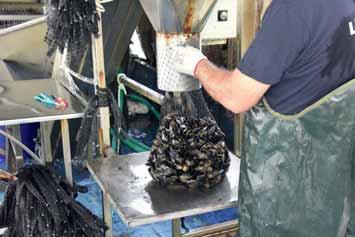


Mussels are a low trophic level species and well-managed cultivation is a sustainable low impact operation. The animals are filter feeders drawing their nutrition from the naturally occurring plankton in the water—they are not given any feed. Growth is aided by stable climatic and water conditions. Apart from their use
as food for human consumption mussels are also believed to compensate for the nutrients released from fish farming operations. Lissus Adria grows its mussels the traditional way. Ropes suspended in the water collect the mussel spat during the season which extends from mid-December to mid-April. The spat is then removed from the collector rope and distributed on to other ropes. It takes about one year for the spat to become market-sized mussels, says Mr Suli. The rate of growth depends on a number of factors including the oxygen and nutrition content of the water and its temperature. Today the company produces some 500 tonnes annually, but if and when he is allowed to export, he expects the production to increase. Of the 76 ha for which the farm has a concession only 42 ha are being utilised as the domestic market is currently the only outlet for the production. During the course of the year the mussels are removed from the water cleaned, re-attached to ropes and returned to the water. Any other organisms that have attached to the ropes are also removed during this process, which is repeated five times to ensure the quality of the final product, says Mr Suli.
The mussels that are ready for harvest are large and full of meat.
The company has a harvesting vessel that is equipped with a harvesting belt that feeds the mussels into a de-clumping and washing machine from where they move to the packaging equipment. A mesh net attached to the packager is then filled with the desired quantity of mussels.
The company’s customers are primarily restaurants and fishmongers who place their orders for which the harvesting is then carried out. If demand is low the mussels are not harvested and is there is a lot of demand the harvest is increased. In general, however, over the last few years
demand has shown an upward trend, maintains Mr Suli. The season for harvesting the mussels is from June to November. The water temperature is very suitable for the mussels in this period, the harvests are bountiful, and In the summer months in particular local demand for mussels is high thanks to the influx of tourists.
Global warming is a major concern for the company. The mussels can grow in water that is up

Tonin Suli, director and shareholder
The product is sold on the local market as exports of mussels from Albania to the EU are not permitted.
to 22-23 degrees. Beyond that and they will start to perish. A local institute monitors the temperature of the water in this part of the Adriatic. Temperatures have been fluctuating in the last couple of years, last year for example the water was unseasonably warm while this year it has not been. Mr Suli is hopeful that the rivers that drain into the Adriatic Sea will help to prevent an increase in water temperature that threatens the growth of the mussels. The average temperature in this part of the Adriatic in summer is 24 and in winter is 13 degrees, Mr Suli says, and this combined with the clean water offers good conditions for growing mussels. The warming waters have also resulted in the migration of species that are not typically seen at these latitudes in the Adriatic, but so far none of the invasive species seems to be attacking the mussels.
He looks forward to Albania joining the EU as it will allow the export of Lissus Adria mussels to buyers in the other Member States. The fact that producers there will also be able to export to Albania does not worry him as he feels the Albanian market is much too small to interest producers in countries such as Spain and Italy. Lissus Adria has already been receiving enquiries from traders in EU countries interested in buying mussels, but because of the ban on imports from Albania these enquiries have not developed into contracts.
Product: Line grown Mediterranean mussels
Volume: 500 tonnes/year Facilities: 76 ha of sea area for ropes Market: Albania

The fish processing sector in Albania features a couple of very large companies and several smaller ones. The companies process a variety of fish and shellfish sourcing the raw materials from within Albania and from abroad. The finished products are then sold on the domestic market or exported.
The lower cost of labour has encouraged Italian, Spanish, and Croatian companies to invest in Albania to produce labour intensive products such as salted anchovies Fish Love, based near Shengjin, is an Albanianowned firm that combines fishing activities with a processing operation. Owned by Agron Metvelaj the company has its processing facility in the premises of another enterprise that used to depurate bivalves. The facility has a HACCP programme in place and is licensed to export to the EU.
Today the processing operation is four years old while the fishing activities go back much further. In addition to his own fishing vessel, Mr Metvelaj has contracted a further six vessels to supply him with the raw material that he processes in his factory. Over and above that he imports frozen fish and seafood such as shrimp and European flying squid, as well as salted mackerel. The fresh, frozen, and salted raw material goes into the manufacture of almost 150 products. While the assortment is large the volume of the individual products is generally modest except for shrimp, squid, and anchovies which are the most
Fish Love produces a wide range of seafood products although most of them in modest quantities. Items based on anchovies are among the most popular in the assortment.
popular items. Most (70) of the production is exported with the bulk going to Italy and smaller quantities destined for Greece, Croatia, Macedonia, and Spain.

Mr Metvelaj is interested in expanding both the range of products and the markets he sells them on. He feels there is demand for product variety and is keen to develop and produce new items.
I have several ideas for new products, he says, and am particularly interested in suppliers of northern prawn (Pandalus borealis). He sees a lot of potential in countries
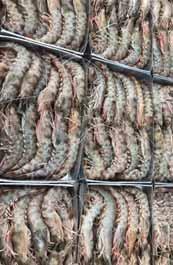
in central and eastern Europe as well as in northern Europe for his products. A further ambition is to invest in a new processing line that will enable the automation of parts or all of the production process. This would result in higher yields and superior quality. However, he is aware that automation
Albania
Owner: Agron Metvelaj
Employees: 30
Raw shrimp are imported from Central America or Asia, processed, and usually exported.
is best suited to production when the volumes are very large and the range of products is limited. For now, Fish Love has a different production model which apart from releasing a wide range of items is also highly flexible and able to adapt at short notice to changes in market and consumer demand.
Markets: Domestic 30%, international 70% (Italy, Greece, Croatia, Macedonia, Spain)
Facilities: Processing factory, fishing vessel
A German company, FIAP offers a range of equipment for the aquaculture sector from sophisticated recirculation systems to hand-held nets.

An aquaculture farm whether on land or at sea is a rough environment and the equipment used needs to be tough and reliable if the farm is to operate successfully. FIAP’s Profifeed BeltFeeder is a mechanically driven automatic feeder that can be used in the most demanding environments to deliver feed or other inputs, such as medicines or additives, to the water. The material can take any form from dust to large pellets. The feeder is started
manually and can be set to run for 4, 12, or 24 hours during which time it will steadily dispense the medium enabling extremely efficient workflows.
Many thousands of customers worldwide, from private users, to scientific institutes, to large fish farms have relied on FIAP Profifeed
BeltFeeders for many years to achieve the best results. The popularity of the original model has led to the design of a professional version, the FIAP Profifeed BeltFeeder PRO, which, in addition to all the features of the standard model, offers an easy-to-remove drive shaft for maintenance and cleaning purposes. This is made of seawater resistant aluminium and is therefore highly durable. Both models can be fitted with 3 kg or 5 kg cases to accommodate
the medium. Although very sturdy pieces of equipment, regular and long-term usage does lead to wear and tear over time. This is normal and is easily remedied as every single part of the two belt feeders can be quickly and easily replaced with a spare allowing them to continue to operate reliably and economically. These feeders make an important contribution to the day-to-day operations on a fish farm and offer the best conditions for excellent growth rates.
A PRO model of the standard belt feeder offers further advantagesFIAP’s Profifeed BeltFeeder (the green boxes) are hardy pieces of equipment that are suitable for many different fish farming operations.
Lithuania’s fish processing sector carries disproportionate weight in the economy









After growing continuously for the 10 years to 2019 the fish processing industry suffered a significant drop in output in 2020 thanks to the impact of the pandemic at different levels. Although it recovered the following year, the effects of the war in Ukraine threaten to set it back again.
The Lithuanian processing sector is important due to its economic size and the employment it generates. It is the 10th largest seafood processing industry in the EU and the 7th largest in terms of employment. e 86 Lithuanian seafood processing companies
in 2021 employed more than 5,100 people. e total production of processed sh reached 136,000 tonnes in 2021 (including products not intended for human consumption) and compared to 2020 it increased by 13 and thereby reached the same level as in 2019, before the
covid pandemic. In 2021, the total income of the Lithuanian processing industry, comprising turnover from processing and other income, was EUR704 million corresponding to a 13 increase compared to 2020, but only a 3 increase compared to 2019.

Overall, the output of the processing sector increased for ten years—from 2010 until 2019. But 2020 was affected by the



pandemic resulting in a 10 drop in both volume and value. The growth in production in 2021 to a level higher than that in the pre-covid period shows that the industry has successfully overcome the challenges presented by the pandemic. Most of the raw material (95 in 2021) used by the fish processing companies for their production was imported, and half the resulting products were exported. Around 86 of the exported production was sold in EU countries. This shows a remarkable switch in the market for Lithuanian seafood products away from the Commonwealth of Independent States (CIS), Russia, Belarus and others, which were the main export destinations a decade ago.
In terms of volume the largest commodities produced by the Lithuanian fish processing industry were surimi and smoked fish including smoked fillets. Each contributed about half to the total weight of production. However, the value of production was significantly higher for smoked fish and smoked fillets. This category contributed about 56 to the total production value compared to 15 from surimi production. The most important species in the production was Atlantic salmon which amounted to 60 of the total value and 35 of the total weight. Around 11 of the total weight derived from processed Atlantic herring (mostly salted) and 7 from Atlantic cod (mostly frozen fillets).
Lithuania maintains a positive trade balance in fish and fish products, with exports consistently exceeding imports. In 2021, the value of exports was EUR603 million, almost EUR79 million higher than imports, and the volume reached 133 thousand tonnes.
According to the Scientific, Technical and Economic Committee for Fisheries, fish processing enterprises are indeed largely different across the EU in terms of labour intensity. If the EU average is around 35 employees per enterprise, Lithuania and Poland have, respectively, 128 and 122 employees per enterprise. Lithuania belongs to that group of Eastern Europe countries, where bigger enterprises dominate the processing sector. Statistics show that the Lithuanian fish processing sector is mostly represented by large scale enterprises: companies employing more than 250 people generate 80 percent of the national turnover and 60 percent of the total persons employed. There are six such companies in Lithuania. Fish processing enterprises, employing 50-249 persons contributed 15 to the total turnover of the sector in 2021, there are 9 companies in the list.
Fish processing enterprises employing 1-49 persons are important because they work with locally sourced fish—the raw material is mostly raised or fished in Lithuania. There are 32 companies in this group. A positive development among some of these companies is that processing of aquaculture products is growing though slowly. Farmed fish is mostly processed by companies whose main activity is not processing; they are mostly aquaculture farms which have fish processing facilities. The increased processing of aquaculture products is related to a significant growth in production while the market for fresh aquaculture products is limited. In 2021, the number of companies with fish processing as a side line increased 18 to 39 from 33 in 2018. In the period
The fish processing sector in Lithuania produces a variety of items from domestic raw material as well as imports. Here, a range of smoked items. 2019-2021, the industry processed around two thousand tonnes of local aquaculture products per year of which carps, rainbow trout, and African catfish comprised 993, 280, and 240 tonnes respectively.
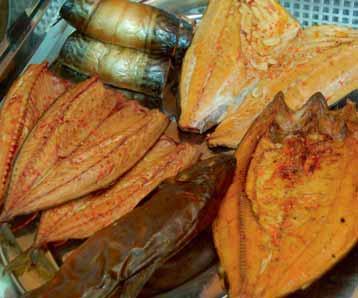
According to 2020 data, most (68) employees involved in Lithuanian fish processing industry were female. The distribution of employees by gender in different size categories were very similar. For example, in large companies (with >250 and 50-249 employees) female workers accounted for 69 of the workforce, whereas in smaller units (11-49 and <10 employees) 60 were female. Some 56 of all employees in the sector had a secondary education, whereas workers with low and high education accounted for 24 and 20 of the workforce respectively. Around 99 of total employees had Lithuanian nationality.
The Russian invasion of Ukraine in February has seriously affected
all EU members and all economic sectors including the fish processing sector. At the time of going to press, energy prices and inflation were still rising, affecting Lithuania’s economy recovery from the effects of covid-19. More expensive energy and high inflation will have an unpredictable impact on the economy. The fish processing sector does not depend on raw materials or processed products from CIS countries, Russia, Belarus, and others, but the war affected Lithuanian trade with Ukraine. In 2022 the country fell to fourteenth place among Lithuania’s export partners from ninth place in 2021, and exports plunged around 40 each in value and volume.
In conclusion the Lithuanian fish processing sector has managed the disruption caused by the pandemic quite well. The sector now faces another difficult situation caused by the Russian invasion of Ukraine, but the expectation is that it will overcome these challenges and continue to grow and develop.
1 Economic report on the fish processing industry, STEFC 21-04
Lithuania boasts some of the largest fish processors in the EU in terms of manpower
Although badly affected by the pandemic when production had to be shut down due to the lack of staff during the important end-ofyear period in 2020, Des managed to turn a profit the following year. Now things look bleak again with soaring costs of inputs, but the company is confident it will weather this storm too.
The company Des started its activity in 1994. The main activity of the company is fish processing, where the raw material is frozen, salted, marinated, or fried. The main products include frozen herring fillets, herring, as well as cod and salmon.
All the raw materials are imported from Norway and Iceland. About 190 people work in the company.
The owner, Gintaras Kanaševi ius, says Des produces about 3,000 tonnes of herring and about 2,000 tonnes of cod and salmon per year.
The company has been granted a European veterinary number for fish products, and a HACCP quality management system has been implemented. Production is exported to the UK, Ireland, Germany, Bulgaria, and USA, as
well as to neighbouring countries—Latvia, Estonia, and Poland.

According to Lina Pilkiene, the Des sales manager, the covid-19 pandemic brought many challenges: sales declined, there were difficulties with logistics and transportation, and finding workers to replace those infected or quarantined became more complicated. As an essential activity, fish processing was not subject to lockdowns, but the company faced the consequences of outbreaks directly in the production processes. The most challenging time during the
Herring, cod, and salmon are the company’s main raw material. Here, fried cod is combined with vegetables.
pandemic was at the end of 2020, when almost every employee was infected or quarantined and Dese was forced to stop almost all manufacturing operations.
As a result, contracts the company had with the biggest Lithuanian supermarkets, Rimi, Lidl, and Maxima went unfulfilled which also had consequences.
There were no employees and no processed production, says Ms Pilkiene. Above all, she emphasises, the end of year is the most important period for the fish industry as sales reach a peak. So, while the year was a difficult one in general, the inability to produce at this crucial time hit the company particularly hard.
Processing activities returned more or less to normal in 2021 and the company managed to enhance its competitiveness despite the fact that no nancial support to deal with the fallout from the pandemic was provided by the Lithuanian authorities. In 2022, however, another unexpected situation arose following the Russian invasion of Ukraine in February. is resulted in a sharp rise in energy and raw material costs and now, huge in ation. Sanctions against Russia meant that Desė needed to nd a new supplier of packaging, since for many years one the main packaging partner had been a Russian company. Desė now has a new contract with a Latvian company, but the price for packaging is much higher
compared with the Russian product.
Currently the main challenge is the price of oil (herring llets are prepared with various oils) which has risen drastically. It is now 3-4 times more expensive than half a year ago. A few years ago Desė started using green energy. A solar plant was installed at the site of the processing factory and now a signi cant amount of electricity is generated each day from this source. e green power will oset the sharp rise in energy prices and reduce their impact on the company’s costs.













In Lithuania, Des ė ’s products are well known. Many have won awards or nominations for “the most popular product of the year”. Although the company is well established on the export market it is constantly looking for new markets and export
partners. And among the potential export destinations that Des ė is considering is Ukraine. e range of products is also expanding, for example, those based on processed cod, and the company is looking for new export markets for this line of products.




After over 20 years of effort, the 164 WTO member states have come to an agreement on fisheries subsidies. By signing the agreement, the states commit themselves to prosecuting illegal fishing and removing subsidies for fleets if the fish stocks they exploit are endangered. This means that, for the first time, doing business at the expense of nature will be directly trea ted as price dumping that can be prosecuted by the WTO courts of arbitration.
oceans accommodate 80 percent of biodiversity and feed billions of people. But around 34 percent of global fish stocks are overfished according to the FAO. The distribution of this valuable marine protein is already the subject of dispute. This makes the work of people who live off fishing more difficult and puts the food security of entire nations at risk. Worldwide, around 39 million people earn their living from catching fish, and fish accounts for nearly 20 of the animal protein needs of 3.3 billion people. Because oceans will continue to play an indispensable role in supplying food in the future, we have a responsibility to preserve these resources for future generations. However, this is difficult if basic market mechanisms are undermined by fisheries subsidies. According to the law of supply and demand, decreasing fish stocks should mean that the price of fish rises and demand reduces, making fishing unprofitable and preserving fish stocks. However, state subsidies ensure that fishing is assiduously continued contrary to all economic logic even if it is not profitable.
Fisheries subsidies globally are estimated at 14 to 54 billion US dollars per year. According to a Canadian study from the year 2019,
Governments support their fisheries sectors with a range of policies including stock management, infrastructure, control and surveillance, research, tax exemptions on fuel and direct contributions to fishers’ incomes. According to the OECD, much of the support goes to input subsidies (such as for fuel and vessels) which can contribute to overfishing.
governments spend around 35 billion US dollars on fisheries subsidies annually, of which 22 billion dollars has “harmful effects”
If these figures are accurate, taxpayers are subsidising more than one third of global fisheries costs. Some 36 percent of subsidies for fisheries come from China and the EU, followed by Japan, South
Korea, Thailand and the USA. Fuel subsidies are the main way fishing is subsidised. Some of the subsidies go towards diesel discounts for vessels and some for giving fishers fuel tax or VAT exemptions. This enables them to continue to head out to sea and to fish outside of their national waters. Financial aid for building new fishing
vessels and associated fishing technology is also common practice in many countries.

According to cautious estimates, since the start of the millennium
at least 400 billion USD has been spent on harmful subsidies, with 60 of this sum accounted for by prosperous countries. But even here there are serious inequalities, since an estimated 81 of the money goes to large industrial fishing vessels. Environmental groups estimate that subsidies in some countries could account for half of the income of large industrial vessels. Without this financial aid, deep-sea fishing would probably often in fact be unprofitable. Compared to the amount of harmful subsidies, the proportion of financial aid that has a positive effect is relatively
small. It goes to, for example, the acquisition of more selective, sustainable fishing gear.
Fisheries subsidies are also quite standard in the EU. The small organisation Our Fish claimed in a 2018 study (“Climate Impacts & Fishing Industry profits from EU Fuel Tax Subsidies”) that EU fishers consume around 2.3 billion litres of marine diesel each year and generate almost 7.3 million tonnes of CO2. Despite these effects on the climate, the EU subsidises fisheries with up to 1.5 billion euro, mainly through tax exemptions. As part of the EU Commission’s Green

Deal, the Energy Tax Directive is now to be reviewed and adjusted in line with energy and climate policy. Environmental groups, however, are criticising the fact that the EU Commission still approved generous financial aid in September 2018 for the purchase of new fishing trawlers in its outermost regions. These include, among others, Guadeloupe, French Guiana, La Réunion, Mayotte, Martinique and St. Martin, as well as Madeira and the Azores.
Although only a few profit from harmful fisheries subsidies, we all pay the price for the overfishing
of the seas. In 2017, the World Bank estimated that, if it was really sustainably operated, the fishing industry could bring in around 83 billion US dollars more per year. Removing harmful fisheries subsidies would lead to an increase in global fish biomass, by 2050 catch quantities could increase by 12.5.
The harmfulness of many subsidies is due to multiple effects. Above all, the promotion of overcapacities in the fishing industry, which are imbalanced compared to fish stocks in the world’s seas, has a negative effect. This can be seen in particular in unsustainable catch quantities, which often exceed the quantities recommended by scientists. The increase in vessel capacity as a result of subsidies also has a negative effect on the climate, since CO2 emissions also increase with the duration and length of fishing trips. Subsidies can even destroy livelihoods, as small-time fishers find it particularly difficult to compete with the subsidised fisheries fleets.
This information is generally not new, since the harmfulness of some subsidies has been known for decades. The pressure to finally do something about this has since increased further, influenced by current developments. Global warming, which is driving some boreal fish stocks towards the poles, is the most important. Small coastal fishers in poorer countries, for whom fishing is often indispensable, are the ones who suffer most due to these changes. Fishing industry methods have also changed. Today they are largely dominated by highly technologised commercial fleets that operate thousands
of kilometres from their native coasts. The deep-sea fleets of the EU countries comprise around 250 vessels, and those of the US around 300. This sounds like a lot, but is actually very few compared to the figures for China. Allegedly, only 2,700 vessels that fished far from the coast were officially registered in China in 2019. These figures are however doubted by the London Overseas Development Institute, whose experts estimated China’s distant-water fishing fleet at 17,000 fishing vessels in 2020.
The Sustainable Development Goals (SDG) of the United Nations are also increasing the pressure to act to solve these problems. In SDG 14.6, it is explicitly stated that all forms of fisheries subsidies that contribute to overfishing, IUU fishing and fishing fleet overcapacities should be banned by 2020. This is intended to take reasonable account of the interests of developing and less developed countries. The negotiations on fisheries subsidies fall into the area of responsibility of the World Trade Organisation (WTO), which was founded in 1995 as the successor organisation to the GATT, with an expanded remit. A mammoth task, since the trust of many states in neoliberally oriented market mechanisms, which are a core philosophy of the WTO, has been shattered since the financial crisis of 2008. The WTO’s work is also made harder by the consensus principle for resolutions, according to which the voice of each country holds the same weight, whether it is a small island state or the powerful USA. Because this entails endless discussions with little
Composition of 2018 fisheries subsidies amount by type and grouped by developed and developing country groups, for 2018 (constant USD)*.

decisiveness, very many WTO members – including the EU –avoid it by coming to bilateral agreements with other states.
The risk would therefore be great that the negotiations on fisheries subsidies would also lead to endless palaver without any tangible successes.
It really was a long and difficult road to reach an agreement. It took more than 20 years until the responsible ministers from all 164 WTO member countries could sign the agreement on this matter on 17 June 2022. The WTO negotiations on fisheries subsidies began in 2001 at the Minister’s Conference in Doha with the declared goal of securing the health of the oceans, fair global trade and food security and greater equity when it comes to the common good of fish. According to the United
Nations, by 2020 the WTO was to reach an agreement that, among other matters, uniformly regulated the problem of fisheries subsidies. This schedule ultimately could not be complied with. One reason for this was that the political wrangling over small details took years. Another was that the coronavirus pandemic caused the 12th Ministerial Conference to be postponed. However, there was movement in the tough negotiations in mid-June 2022. In a marathon session that ended in the early hours of 17 June approaching 5:00 AM, the ministers in Geneva finally acceded to an agreement on limiting harmful fisheries subsidies.
Not all of them, however. Some subsidy areas still had to be left out in order for all 164 WTO members to reach a tolerable compromise. Nevertheless, the consensus does represent progress. States that allow or even
promote IUU fishing can now be prosecuted before WTO courts of arbitration. Governments will also be required to report their fisheries subsidies to the WTO in future. Compliance with the agreements – with the option to strengthen them – is to be reviewed every 5 years. All WTO states are requested to negotiate further on the missing details in the agreement and to close the loopholes. Ngozi OkonjoIweala, the Director-General of the WTO, even effusively described the agreement negotiated as “the greatest advance of all time”. The WTO has shown that it can react to the challenges of the times. The specifications apply exclusively to fishing at sea and not to aquaculture and inland fisheries.
Originally the agreement aimed to eliminate overcapacities in
fishing fleets and to stop overfishing. However, these areas were largely removed from the draft agreement in order to reach as wide a consensus as possible among the WTO states. The final version bans harmful subsidies that support IUU fishing as well as the exploitation of overfished fish stocks (regular reports must be submitted on the state of stocks exploited by fishing). Subsidies for fisheries in marine areas that are not managed by regional fisheries management organisations were also banned. All WTO states are obliged to conscientiously and promptly implement the framework set out and to continue to negotiate the details that are still outstanding. Further recommendations for a more comprehensive agreement are to be introduced as soon as the next ministerial conference. The members have been given a deadline of four years after the agreement enters into force to agree on corresponding regulations. Developing countries are to be supported in converting their fisheries according to the specifications of the agreement negotiated. This primarily means more generous deadlines for implementation and more flexibility in financing.
Although the agreement still contains numerous open questions and does not solve all problems with regard to fisheries, it represents a decisive step in the direction of greater sustainability. This advance does merit the adjective “historic”, since it is the first agreement between WTO members with ecological sustainability rather than economic interests at its heart. The fisheries agreement represents an important step in the direction of sustainable exploitation of marine resources, healthier oceans and
preserving biodiversity for people and nature. Also, profiting at the expense of nature can now for the first time be treated as price dumping and prosecuted by WTO courts of arbitration.
Despite these successes, there has of course been criticism of the agreement. It concerns in particular the exemption regulations, as the WTO negotiators had to slim down the draft text where appropriate because otherwise the negotiations threatened to break down. The main deletions were with regard to the subsidies for marine diesel and the VAT exemptions that are standard in many industrialised countries. The passages regarding this are not found in the final version of the agreement because the more prosperous countries pushed their interests and obtained exemptions to their advantage. Several developing countries are therefore accusing them of disadvantaging small fisheries in the Global South. India above all insisted to the WTO that the industrialised countries stop their fisheries subsidies and stop fishing the oceans empty in freely accessible zones. It claims that the WTO agreement is imbalanced, because it makes it more difficult for poorer coastal inhabitants to officially register as fishers and to invest in sustainable catch methods. The approval procedures for fisheries as well as the reporting obligation regarding the state of fish stocks are claimed to require a “crazy amount of effort” and to be much too complicated for developing countries. The required monitoring of fish stocks is said to represent an almost insurmountable task for island
states such as Mauritius, whose coastal waters are larger than those of Germany and France combined. This is why, according to critics, significantly longer transition periods are necessary, so that administration and fisheries management can be equipped accordingly and the extended requirements can thus actually be implemented.
Some developing countries are also annoyed that the fuel vouchers given by them to small-scale fishers are classified as a “specific subsidy” and are therefore not allowed according to the agreement. They want their fishers to be able to fish further out to sea with their subsidised fuel and not only directly by the coast. According to the regulations of the agreement, this must now be registered at the WTO and there is significant doubt that it will be approved. In contrast, the VAT exemption for marine diesel practised in the USA or the EU is permitted as a “non-specific subsidy”. It is therefore no surprise that this practice is viewed as unfair by many developing countries.
On the other hand, some industrialised states accuse other countries of unjustifiably claiming the status of a developing country because of the associated benefits, less stringent requirements and exceptions. While the World Bank has unambiguous criteria for developing and industrialised countries, in the WTO each country can decide for itself what group it belongs to. This strange regulation best explains why the economically strong China, with its
enormous deep-sea fleet and the most fisheries subsidies globally still claims the status of a developing country for itself. This is particularly strongly criticised by the USA, and the EU is also demanding that China voluntarily waives any preferential treatment. To change this situation, however, a reform of the practice of assignment would be required. The USA has already suggested a catalogue of binding criteria for the status of a developing country. However, it has little prospect of success, because it would mean that not only China, but also some other countries would lose their status and the associated advantages.
Great celebrations over the agreement negotiated would in fact be premature, because the real work has only just begun with its signing. While the rapid implementation of the agreements is publicly required and there is a push to eradicate the remaining weak points, almost all of the parties are secretly continuing to pursue their own agendas. For example, Piyush Goyal, India’s Minister of Commerce and Industry, is demanding that the rights of Indian fishers “must not be restricted in any way” . According to him, it is primarily the industrialised countries that should come to a deal, because they bear the main responsibility for the decimation of fish stocks in the oceans. The EU is also claiming exemptions for itself. It would like to support fishers who contribute to the stabilisation of fish stocks with subsidies, regardless of whether the measures are shown to actually have an effect in the end. The problems with fisheries subsidies therefore appear to remain unsolved by the WTO agreement. mk
Diets free from animal products such as vegetarianism and veganism have now achieved wide social acceptance. Increasing numbers of manufacturers wish to exploit this niche market by offering vegan fish. The market researchers at Fact MR predict that trade in vegan fish products will grow by 28 percent annually until 2031. What can consumers expect today from plant-based fish replacements?
According to the 2021 Food Report from the German Federal Ministry for Food and Agriculture, in 2020 approximately 10 percent of people in Germany were vegetarian and 2 percent were vegan. The motivations for this development are varied and include meat and food scandals in recent years, animal welfare and the climate crisis and the overfishing of the seas. But although most vegetarians and vegans avoid animal products, many do not wish to go without their taste completely. This creates an opportunity for the manufacturers of plant-based replacement products, who are developing many new ideas in order to make vegan food resemble the originals as much as possible both visually and in taste and texture. This also applies to vegan fish products! The market for plant-based fish alternatives is still relatively small, but it has significant potential for growth. The Good Food Institute (GFI) estimates the market for vegan meat, which also includes seafood alternatives, at almost 1.4 billion US dollars. Currently, fish and seafood make up only 1 of the vegan meat market, but this will change. There is a great willingness to invest, as developments in the USA have shown. There, only 4 million USD was invested in the vegan seafood sector
in 2017. The investments reached 16.7 million US dollars by 2018, and as much as 41 million US dollars in 2019.
According to Good Food Institute, in the first six months of 2021 alone, this total rose to 116 million US dollars, partly due to crowdfunding. Both large corporations and small startups benefited from this, as both are surfing the same wave. The GFI lists 86 producers of alternative fish products worldwide. And this number seems to be growing consistently. There is significant optimism, since the global plant-based seafood sector is predicted to expand by an average of 28 percent per year over the next decade. The market research company Fact MR forecasts that the sector could reach a value of 1.3 billion US dollars by 2031. This is significant, but vanishingly small when compared to the global market for real fish and seafood, which is estimated at 586 billion dollars by IMARC Group market researchers. Salmon alone accounts for a good 50 billion dollars of this!
Manufacturers are attempting to imitate the taste, texture and
mouthfeel of the original products as perfectly as possible with their “fake fish” products. This is a significant challenge in itself, because the complex fibrous texture of animal muscle tissue is very difficult to create with plantbased raw materials, even with technical aids. This is why the range of vegan seafood products is currently still limited mostly to minced type fish alternatives such as fish fingers or fishcakes. Achieving the right scaling of manufacturing processing is at least as difficult, since industrial quantities must be produced to achieve the desired success on the market. It remains to be seen whether the capacity of 3D printers, which some producers are currently using, will actually be sufficient. This does not discourage the high-flying ambitions of the pioneers in this area, however. Some even claim to be “rethinking animal food”, “revolutionising the food sector” and thus “making the world more sustainable and a little bit greener”.
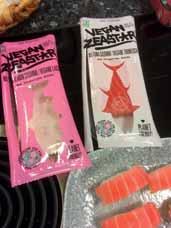
When it comes to vegan replacements for shrimp, companies from the USA and Asia such as New Wave Foods, Shiok Meats or The Plant-Based Seafood currently seem to have the technological advantage. But the European companies are
Salmon and tuna, which are particularly loved by consumers, are also favourites in the vegan alternative products segment.
catching up, not least thanks to industry leaders like Nestlé or Frosta. In order to be successful on the market in the long term, plant-based alternatives to fish, meat, milk, cheese or delicatessen products must offer consumers a familiar taste experience and the usual bite. Texture and microbiology, allergenic potential, aromas and nutritional profile, complete expertise in the production process – everything must be right for a halfway authentic “fake fish” to be produced at the end. However, whether this must really be the case is a topic of controversy even among vegans. Why should a vegan product imitate the form, texture and taste of something
Some manufacturers already offer complete ranges of alternative fish and seafood products made from plant-based raw materials.
that you really do not want to eat any more? Perhaps this is the reason why some manufacturers are for the first time saving themselves the cost and effort of trying to produce a type of fish surrogate with many ingredients and processing steps. The abandonment of this approach is justified by the claim that many consumers do not like the taste of fish anyway. In contrast,others do not reject this goal and are seriously attempting to create a fish aroma that is as authentic as possible with seaweed and seaweed extracts.
A purely plant-based diet is of course possible in principle, but with vegan fish, manufacturers are finding it difficult to offer consumers the nutrients and health advantages that are naturally present in fish that ultimately make it advisable to eat. There are hardly any vegan products that do not have thickening agents, acidity regulators, aromas, and sometimes also preservatives. Many ingredients lists resemble short novels. Product tests by the German consumer organisation Verbraucherzentrale Hessen (Consumer Advice Centre Hessen) show that alternative products not only contain less protein than real fish, but it is
often of worse quality. Most significantly, the important essential amino acids are often lacking.
Peas, lentils or beans, soya, lupin and wheat or mushrooms and protein-rich vegetable varieties such as cabbage are not a complete alternative when it comes to their amino acid profile. Carrots are healthy, but cannot replace oily marine fish. This primarily applies to omega-3 fatty acids as well as vitamin B12, which are present in high quantities in many fish species. The omega-3 fatty acids in flaxseed, rapeseed, hemp or walnut oil contain mainly linolenic and alpha-linolenic acids, which can only be converted into the high-quality DHAs and EPAs that are typically present in fish to a very limited extent. However, this problem can be solved with microalgae and algal oils (e.g. with omega3-rich schizochytrium algae). This has the disadvantage that microalgae cultures are energyintensive and therefore expensive. Another point of criticism is the high level of processing of the isolates and extracts from algae.
In addition to the many ingredients, the high level of processing for vegan alternatives is one of the most common points of criticism from product testers. However, manufacturers can rarely avoid this if they want their products to have textures and aromas similar to fish. However, food scientists warn that highly processed foods with many ingredients are less recommended for a balanced diet. Many vegans, who are usually quite well versed in nutritional matters, try to eat natural food that is processed as little as possible, just as our grandparents once ate. Vitamins, minerals and trace elements usually present no issue with a purely plant-based diet. The only vitamins that can present
difficulties are vitamins D and B12, because they are almost exclusively present in animal food. Potential iodine deficiency can be avoided by using iodised table salt or seaweeds, regardless of the type of seaweed in vegan products: hijiki, nori, wakame or kombu. Seaweeds not only provide the desired fish taste, they also provide the so-called umami flavour that makes dishes particularly full-bodied.
However, there are also vegan fish alternative products for which the “fishy” taste is reproduced with synthetic aromas created in the laboratory. Gelling and thickening agents are frequently used as adhesive for holding vegan products together. These include methylcellulose, a binding agent obtained from plants that is thought to damage intestinal mucosa and cause inflammation if consumed regularly. Vegan products can also contain various types of sugars and stabilisers that lower the nutritional value of these fish alternatives. Whether manufacturers, with their cocktails of ingredients, are actually succeeding in imitating the authentic taste of fish and seafood depends, of course, on subjective sensory impressions, expectations and the willingness of consumers to accept such alternatives. Still, a considerable selection of vegan fish and seafood products is already available to them and it is becoming ever wider: vegan salmon made from carrots, tuna made from tomatoes, soya or seitan, fish stock made from dried mushrooms and seaweed, fish fingers and fish fillets made from tofu, vegan Bismarck herring based on aubergine, fishcakes made
from jackfruit, calamari made from king trumpet mushrooms, herring salad based on beetroot, fried aubergine, apple, nori and pickled gherkins, vegan jumbo prawns and scampi made from yam root, lobster made from tofu, prawns made from peas, seaweed and konjac root or artichokes and palm hearts. Vegan caviar based on seaweed has already been available for some time. It is now even sold by IKEA.
Plant-based alternatives are now available even for challenging products such as scallops or smoked dogfish. Manufacturers are very imaginative when it comes to giving their products typical fish features. They use soya or wheat protein, black salsify, jackfruit, cauliflower, borlotti beans, hempseed protein and celery as raw materials, to name just a few. Curdlan gel, a carbohydrate formed by bacteria, glucomanna, a starchy substance from the konjac root, trehalose made from seaweed and tapioca starch made from manioc root are used. Not all of these are equally sustainable, sometimes the promised climate neutrality can only be “bought” through CO2-offsetting and afforestation projects. Some manufacturers are not quite so creative when naming and marketing their products as they are with the raw materials used. Most have gone with V, which serves as a kind of synonym for vegan and vegetarian. The vegan shelves of retail outlets in Germany are filled with Vantastic Visch, BackVisch, Visch & Chips and Vischburgers, Veganelen, NoVish-Burgers and Thun-Vish.
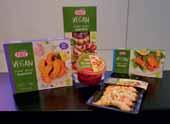
There is no doubt about it –vegan fish alternatives are on
the rise and are preparing to conquer the mainstream. It is a promising market, in which both well-known large food corporations as well as small startups – some with amusing company names such as Lord of Tofu or Keine Mærchen (No Fairytale)–are vigorously competing. Sometimes they even work together, as in the cooperation between the Dutch company Novish, founded in 2019, with the Nordsee restaurant chain. The products of large food producers, such as Garden Gourmet Thun-Visch from Nestlé, are, however, viewed with suspicion by dedicated hard-core vegans and often even rejected. More out of principle, because they generally distrust Nestlé, than for taste reasons, since more tolerant vegans attest that Thun-Visch can hold its own against real tuna from a tin quite well. A quick look at the internet shows that consumers do not hold back in their verdicts about vegan products. In addition to
enthusiastic praise (“fantastic”, “extremely tasty”, “really great”), there are also criticisms, some modest, but some quite severe. Examples of criticisms include that some ingredients are not organic, the smell is overpoweringly fishy or reminds them of menthol sweets, for some the consistency is too firm, too soft, somewhat jelly-like or even slimy and mushy. Some say that one tuna alternative reminds them of vegan chicken, others even compare carrot smoked salmon with carrot salad, one plant-based fish fingers product is said to taste like deep-fried vegetables, leeks in particular.
Clearly, some vegetarians and vegans have very high standards for alternative products. A particularly frequent complaint is that the taste bears little or no resemblance to the original. This is surprising, however, as anyone who voluntarily bites into tofu lobster or carrot smoked salmon
purely for reasons of conscience should really know what awaits them and what they are letting themselves in for. And the question presents itself as to which groups of consumers are really turning to vegetarian or vegan retail alternatives to animal food, including fish and seafood products. In its annual Food Report for 2021, the German Federal Ministry for Food and Agriculture provided some initial answers. Clearly, curiosity is one of the main motivations, as 71 percent of consumers stated that they bought vegetarian or vegan alternatives for this reason alone. Animal welfare reasons were the decisive ones for purchasing for 59 percent of people, and protecting the climate and environment for 54 percent. Almost one third of consumers put plant-based alternatives in their trolleys on a regular or frequent basis. Another 13 percent have bought them at least once. Younger groups of consumers
(47 percent of 14 to 29 year-olds, 38 percent of 30 to 44 year-olds) buy such products particularly frequently and location is also important. The bigger the city, the larger the proportion of consumers that regularly buy vegetarian or vegan products. In small towns with less than 5,000 inhabitants, this number is 20 percent on average, but for large cities with more than 500,000 inhabitants the proportion is 46 percent. There is a simple rule of thumb that in urban regions with generally younger customers, interest in vegan products will be greater than in rural regions with an older customer base.
Vegan fish alternatives require buyers to make a significant financial sacrifice. None of the common vegetarian or vegan fish replacement products is currently being sold for a lower retail price than
the animal product original. Are vegan alternatives then at least healthier and do they keep well, as manufacturers often confidently promise? A look at the ingredients list offers some orientation, since many beneficial substances contained naturally in real fish must be added to plant-based products with supplements such as amino acids, fatty acids, seaweeds or oils.
Verbraucherzentrale Hamburg (Consumer Advice Centre Hamburg) put some vegan fish products from supermarkets on the test bench.
What the Verbraucherzentrale (Consumer Advice Centre) testers found undesirable and criticised
was primarily the fact that some raw materials came from very distant regions, which negatively affected the sustainability of the products. The bioavailability of fish protein is higher than that of plant-based protein sources. Many vegan products contain little omega-3, but far more omega-6 fatty acids, which are thought to increase inflammation. This unfavourable relationship is a consequence of the preferred use of sunflower oil, which is cheaper than expensive olive oil or flaxseed oil. Aroma additives in vegan products are frequently criticised, as is the use of carrageen (e.g. in Vegafit Vischstäbchen) which the Verbraucherzentrale (Consumer
Plant-based alternative products for fish and seafood are not yet as familiar on the market as vegetarian or vegan meat and sausage alternatives. Some recommendations for the right retail presentation appeared in the food placement strategy section of the magazine Lebensmittel Praxis:
• Fish replacement products should be placed as close to classic fish products as possible, so that they are easier for customers to find or to discover for the first time.
• Shelf stoppers can also be used to draw attention to vegan replacement products.
• Flyers at the POS support sales by providing information about the product or the entire product range, and mentioning regional overfishing.
• Since it is younger groups of consumers who primarily turn to these products and many of them use social media
channels, these channels should be used as sources of information.
• Placement and advertising are particularly effective on holidays when fish is typically consumed such as Christmas, Easter or during veggie action weeks.
• Combined placements such as vegan fish fingers with vegan remoulade are recommended.
• Recipe suggestions and tastings can encourage customers buying such products for the first time.
Refrigerated fish replacement products, depending on the market and range, can also be presented in the vegan section next to the meat, sausage and milk alternatives. The cold chain must be complied with and the use by date checked regularly. The first-in-first-out principle also applies to this product group.
Advice Centre) found to be concerning in large amounts. The above-average salt content was viewed particularly negatively, as almost all vegan products are clearly above the recommended nutritional guidelines.
The final evaluation for plantbased fish and seafood products is therefore patchy, even for vegetarians and vegans. Generally, most of them can live with this, but enthusiasm is limited. Many
hope for new products that taste better. The gap between expectation and disappointment was described memorably by Megan Mayhew Bergman (The Guardian, 2 Jan. 2021), who herself is part of the target market for vegetarian seafood. When she served her daughter vegan tuna on toast, she complained: “Oh Mom, please don’t make us eat that”. Even Megan herself wasn’t convinced by this type of product – yet. mk

Producing vegetarian fish analogues is as much about the raw materials as it is about the technology that brings them together. When prepared, analogue fish should ideally look as well as taste like the real thing. An Austrian start-up uses 3D printing to create salmon and other seafood products. A technology used in many other fields, 3D printing, also called additive manufacturing, works by depositing very fine layers one on top of the other to create a three-dimensional structure. Because the process can be minutely controlled it opens up a range of possibilities in terms
of shape, texture, and flavour, while also reducing waste. At the end of May the start-up, Revo Foods, launched its salmon fillet at an event that also featured the company’s plant based smoked salmon slices and its upcoming fish spreads. Based on pea protein, algae extract, and plant oils, the fillet offers high protein levels as well as the healthful omega-3 fatty acids. Moreover, just like the real thing, it can be prepared in several different ways. The company expects the fillet, which took two years to develop, to be available in stores from early 2023.
Your fillet has been freshly printed, ma’m
Micro- and radio frequency waves offer advantages over traditional thawing methods

Based in Lyon, France, Sairem produces machines that generate radio frequency energy or microwaves for a variety of food related applications.
fresh foods such as aquatic products, which have a high water content, with radio frequency (RF) is a way of extending the shelf life of the product without using chemical treatments. This removes the risk of any chemical residue in the product while achieving a later best before date. RF offers the advantages of rapid heating, deep thermal penetration, low cost and better quality control. RF heating can be used to cook, reduce microorganism counts, thaw, blanch, or disinfest food items.
RF energy is produced in an RF generator which converts electricity into radio frequency waves. This energy is used to heat products and RF generators are therefore mainly used for thermal processes. When used in food processing, an RF generator enables food items to be quickly tempered or defrosted. Both RF and microwave frequencies are heating and drying technologies that work in more or less the same way: heat is generated when an electromagnetic field passes though the product. This electromagnetic field causes the molecules inside the material to vibrate which generates heat. Both technologies differ from conventional heating methods in that they warm the product uniformly throughout its volume. Other heating methods
heat the product from the outside in by conduction. The main difference between RF and microwave technologies is the wavelength of the radiation that is produced. This has a bearing on how the energy travels and gets transmitted to the product.
With RF generators the energy travels from one electrode to the other passing through the product and warming it. These generators are suited for warming products with a regular shape. The wavelength of the electromagnetic radiation they create at around 10 m is longer than that of microwaves. The radiation penetrates deeper into the product making them ideal for thick items. Since they warm the product more slowly than microwaves, they can be used for more delicate products. Microwaves, on the other hand, are created by a microwave generator and have a wavelength of 10-30 cm. They are particularly effective at treating products at high speed, especially those which have an irregular shape. The speed and uniformity at which they heat makes them ideal to quickly heat or dry food stuffs and to pasteurise liquids. Both technologies, radio frequencies and microwaves, improve thermal processing in the food industry as they can heat rapidly, uniformly, and preserve
taste, colour, nutritional profile, and quality of the product without the use of any additives. Moreover, they can be combined with traditional heating techniques to give a comprehensive thermal treatment.
Sairem has worked with industrial solutions using microwaves and radio frequency technologies since 1978, when the company was established. It has a strong focus on research and development and has patented many of the technologies and processes it has developed. Most of the components are designed in-house, whether mechanical, electronic,
or software which contributes to the quality and reliability of the equipment it sells. For food processors the company provides food safety and process efficiency with its MW and RF generators by shortening thermal processing times and reducing the growth window for bacteria and other pathogens. The technologies are reliable and very safe as the machines are closed and fitted with sensors in the case of MW generators, and interlocks in the case of RF generators to prevent any leakage of radiation. They are approved for use in the processing of organic products. In addition to shorter processing times these technologies heat from the inside out, eliminate cold spots, and enable precise temperature control. The ability to precisely
choose the time and temperature of the process also ensures that bacterial growth is limited, thus contributing to the safety of the final product. Over and above this, the technology is energy efficient and based entirely on electrical energy, so there are no greenhouse gas emissions at the production plant.
Using RF or MW technologies to temper or defrost raw materials is not only quicker than traditional methods but also lessens drip loss and thereby improves the yield from the raw material. The
homogenous temperature of raw material that is subjected to RF or MW is also better for subsequent processing operations which become more efficient and result in a better final product. The heat treatment can be arranged so that the material is treated continuously or in batches depending on the requirements of the processing operations. For fish processing operations Sairem offers both an RF and a MW solution depending on the customer’s requirements. The machines are rated to deliver power varying from 5 to 300 kW.
Sairem’s new generation of pasteurisation tunnels are suitable for all types of
ready meals or for individual components. Depending on the ingredients and the customer’s process, the tunnel can either pasteurise only, or cook and pasteurise at the same time. The latter is more suitable for fish and seafood as cooking times need to be short. The more sensitive the ingredient, the
better MW technology is suited to it. The tunnel pasteurises at a maximum temperature of 95-100°C depending on the product. It processes all types of trays no matter the size or the composition - plastic, glass or paper based. It can also be used for thermoformed packs and pouches.

The FISH INFONetwork (FIN) consists of seven independent partners who cover all aspects of post-harvest fisheries and aquaculture. Fifty national governments have signed international agreements with the different FIN services and are using the expertise of these services to develop the fishery sector worldwide.
The FIN pages are a regular feature in the four network magazines
- INFOFISH International, - INFOPESCA Internacional, - EUROFISH Magazine
- INFOSAMAK Magazine
They present the FIN-wide spectrum of activities, showing actions and results.

The FIN has more than 70 full-time staff and works with more than one hundred international experts in all fields of fisheries. Through its link from FAO GLOBEFISH to the FAO Fisheries Department, it also has access to the latest information and knowledge on fisheries policy and management issues worldwide.
The execution of multilateral and bilateral projects is one of the main activities of the network. It is also widely known for its range of publications and periodicals as well as for the organisation of international conferences, workshops and training seminars. All eight services offer different possibilities for co-operation with the private sector, institutes, government offices and donors.
For more information on the FISH INFONetwork visit the website http://www.fao.org/in-action/globefish/background/fishinfonetwork/en/.





The e-photobook on the International Year of Artisanal Fisheries and Aquaculture 2022 (IYAFA 2022), which was launched on 29 March 2022, has been published online. The book is an output under a Letter of Agreement between the FAO Regional Office for Asia and the Pacific and INFOFISH. Special thanks are due to the many local, national and regional organizations, authorities, and other stakeholders who have made it their mission to shine a spotlight upon the men, women and children in the small-scale fisheries and aquaculture sector in the unshakeable belief that they and their contributions matter. The most important acknowledgement goes to the millions of small- scale fishers, fish farmers, and fish workers throughout the world who harvest, process,
Asia is home to the majority of the world’s small-scale fishers, fish farmers, and fish workers.


and market fish and fishery products, often under difficult and tiring conditions. The world is indebted to them.
The publication can be downloaded at: https://www.fao.org/3/cc0026en/cc0026en.pdf
Eurofish International Organisation together with the Polish Ministry of Agriculture and Rural Development, the National Marine Fisheries Research Institute, the Polish Association of Fish Processors, and the Polfish trade fair organised a one-day workshop on technology innovation and market opportunities. The event was held on 13 September in Gdansk, Poland and attracted some 80 participants from Poland and from other countries in the region and beyond, Among the speakers, Magnus Fossheim from Marel, a leading manufacturer of food processing equipment including for the seafood industry, identified some of the broad trends that will shape the future including the shift in economic power from west to east, the increase in global population, and the growing complexity of technology. He mentioned the capabilities that seafood processing companies will need including higher yields, greater agility, increased throughput and less downtime, to succeed in their activity.
But how much fish should consumers be eating at all? In her presentation, Danuta Łukaszewicz from Lisner, a Polish processing company, introduced the Nutri-Score, a food labelling system developed by the French Public Health Agency that uses a combination of letters and colours to express the energy value and nutrient content of a food product. Several fish products, however, were rated D, the lowest but one rating. She provided an example of how to increase a product’s score. Salted herring fillets when combined with rapeseed oil in the ratio 80:20 were rated D, but when onion and pickled cucumber were added so that the ratio changed to 40:40:20 (fish, vegetables, oil), the rating went up a notch to C. The European Fish Processors Association, she showed, has suggested adding new categories such as protein and omega-3 content, as that may offer greater clarity. The French system is not the only one in Europe—similar attempts are made in Italy, the UK, and Scandinavia, but whether it will lead to healthier lifestyles and less obesity remains a question.
The FISH INFOnetwork (FIN)INFOPESCA INFOSAMAK
The workshop featured several presentations which are available on the event website (https://eurofish.dk/events/2022-09- regionalworkshop-gdansk/).
The Committee on Fisheries (COFI) is an intergovernmental body where FAO member country representatives meet to discuss the challenges and issues facing fisheries and aquaculture. COFI provides periodic recommendations and policy advice to countries, regional fishery bodies, civil society organizations, and actors from the private sector and international community. It has developed and encouraged the adoption by countries of several binding agreements as well as non-binding instruments that have moved the fisheries and aquaculture sector in the direction of greater sustainability. Most recently COFI endorsed voluntary guidelines on the transshipment of fish in an effort to reduce IUU fishing. The guidelines aim to regulate, monitor and control transshipment to support sustainable fisheries and further close loopholes that enable fish derived from IUU fishing to enter the market. Transshipment refers to the direct transfer of a cargo from one vessel to another before it is recorded at its final destination. It can take place in various locations, including ports, coastal waters and the high seas. While transshipment can be essential to reduce operating costs and maximize sustainable fishing opportunities, if not properly regulated it can be used to disguise illegally caught fish, undermining national, regional and global efforts to curb IUU fishing. States, regional fishery management organisations (RFMOs), and other bodies will benefit from the guidelines as they will offer standards for developing their policies and regulations that govern transshipment, with a view to integrating these in regulatory frameworks for sustainable fisheries management. The guidelines recommend, among others, that states and RFMOs adopt transparent reporting procedures, share transshipment data, and ensure that vessels involved in transshipments are authorised by their flag, coastal or port state and that they notify the authorities before making any transshipment.
Fishery Industries Division FAO
Viale delle Terme di Caracalla I 00100 Rome, Italy Tel.: (+39) 06 5705 6313/5059
Fax: (+39) 06 5705 5188 globefish@fao.org www.globefish.org
INFOPESCA Casilla de Correo 7086 Julio Herrea y Obes 1296 11200 Montevideo, Uruguay Tel.: (+598) 2 9028701/2 Fax: (+598) 2 9030501 infopesca@infopesca.org www.infopesca.org
INFOFISH 1st Floor, Wisma LKIM, Jalan Desaria, Pulau Meranti 47120 Puchong, Selangor, Malaysia
Tel.: (+603) 8064 9169 / 9305 Fax: (+603) 8060 3697 infish@po.jaring.my www.infofish.org
INFOPECHE Tour C -19éme étage, Cité Administrative, Abidjan 01 Cote d'Ivoire Tel.: (+225) 228980 / 213198 / 215775 Fax: (+225) 218054 infopech@africaonline.co.ci
EUROFISH H.C. Andersens Boulevard 44-46 DK-1553 Copenhagen V Denmark
Tel: (+45) 333 777 55 Fax: (+45) 333 777 56 info@eurofish.dk www.eurofish.dk
INFOYU Room 203, Bldg 18, Maizidian Street, Chaoyang District Beijing 100026 P.R. China
Tel.: (+86) 10 64195140 Fax: (+86) 10 64195141 infoyu@agri.gov.cn
INFOSAMAK 71, Boulevard Rahal El Meskini 16243, Casablanca, Morocco Tel.: (+212) 22 540856 Fax: (+212) 22 540855 infosamak@onp.co.ma www.infosamak.org
European Commission (DG MARE); FranceAgriMer; Iceland; Bord Bia, Ireland; ANDA, Morocco; Norwegian Seafood Council; Ministry of Oceans and Fisheries, Republic of Korea; Ministry of Agriculture, Food and Environment, Spain; Swedish Agency for Marine and Water Managment; Seafish, UK; ASMI, USA
Argentina, Belize, Brazil, Columbia, Dominican Republic, Honduras, Mexico, Nicaragua, Uruguay, Venezuela
Bangladesh, Cambodia, Fiji, India, Iran, Malaysia, Maldives, Pakistan, Papua New Guinea, Philippines, Solomon Islands, Sri Lanka, Thailand MEMBER COUNTRIES
Benin, Cameroon, Congo, Côte d’Ivoire, Eritrea, Gabon, Gambia, Ghana, Guinea, Guinea-Bissau, Liberia, Mauritania, Morocco, Namibia, Nigeria, Senegal, Sierra Leone, Togo
Albania, Croatia, Denmark, Estonia, Hungary, Italy, Latvia, Lithuania, Norway, Poland, Romania, Spain, Turkey
China
Algeria, Bahrain, Djibouti, Iraq, Libya, Morocco, Mauritania, Palestine, Sudan, Syria, Tunisia, Yemen
The war in Ukraine has severely affected fisheries and aquaculture production
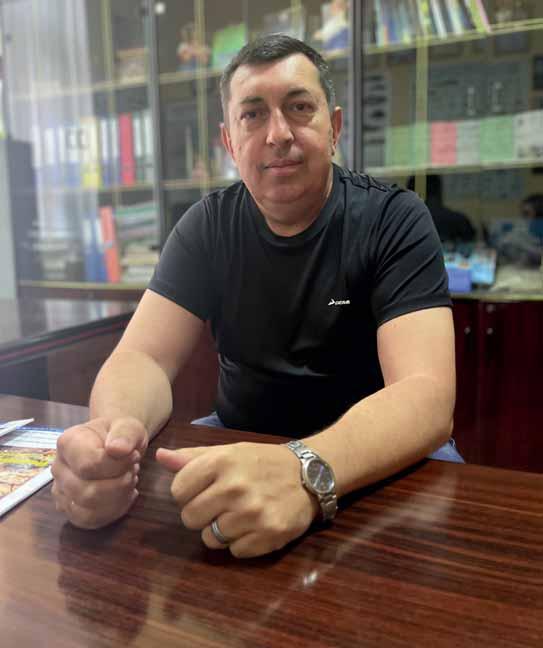
Based in Kiev, the Methodological and Technological Center for Aquaculture provides aquaculture consultancy services to individuals and companies interested in starting an aquaculture business. The advice is multifaceted and can relate to biological, legal, or commercial aspects of fish farming. Yuri Sharylo, the director of the center analyses here the impact of Russian aggression on the sector.
The war in Ukraine has been devastating for the country’s economy. But some sectors must be worse affected than others. What has been the impact on the fisheries and aquaculture sector so far and what will it be in the long term. How much has it been set back and how long will it take to recover?
To monitor the impact of the military aggression on Ukrainian aquaculture, the Methodological and Technological Center for Aquaculture has conducted a study, the full results of which will be published on our website and on social media. Given the temporary occupation of almost 20 of the territory of Ukraine (as of August 2022), the research was conducted through surveys via the Internet, social networks, telephone and by mail. The objective of this study was to obtain information directly from the industry about the impact of the military actions and martial law on the fish farming sector in Ukraine, analyse the data and try to predict the future prospects of the sector. We previously had established the extent of the destruction of aquaculture facilities during the hostilities: as of July 1, 2022, out of approximately 120 pond fish farms, 14 farms located in the north and
south of Ukraine were destroyed to varying degrees (Kyiv, Zhytomyr, Chernihiv, Sumy, Kherson, Mykolaiv and Odesa regions).
In the Central and Western regions, the destruction of fish farms has not been registered. Military operations in Eastern Ukraine and Crimea have been taking place since 2014, therefore there is no possibility to conduct research there. For the time being, we cannot fully monitor the destruction of fish farms in the Kharkiv, Luhansk, Donetsk, Zaporizhzhia, Mykolaiv and Kherson regions where there are currently active combat operations. Some areas of Dnipropetrovsk and Odesa regions are under fire. The destruction of aquaculture production capacities of Ukraine is constantly being monitored, but we will be able to estimate their volume and monetary value only after the active phase of hostilities and the complete de-occupation of our country. In addition, the enemy is conducting constant missile attacks on the entire territory of Ukraine, so any fish farming enterprise of Ukraine can be destroyed, and not only pond farms.
Regarding the restoration of the production capacity of Ukrainian aquaculture, we have the following forecast: − 3-5 years after the full end of the war will be needed to reach stabilization of the aquaculture sector and the pre-invasion production indicators; − by 2030, we expect the gradual implementation of the provisions of the EU legislation for fish farming in inland water bodies (Birds Directive, Water Framework Directive etc.), active introduction of modern efficient practices
where reasonable (taking into account that currently Ukrainian aquaculture consists primarily of carp breeding in ponds), innovative production processes, modern biotechnologies in aquaculture.
As for fishing, it is now completely suspended in marine waters under the jurisdiction of Ukraine. Its restoration will not begin immediately after the end of combat operations, but only after a thorough study of the state of the marine environment and an assessment of whether it is safe to use marine living resources. In internal water bodies, commercial fishing has been partially suspended for safety reasons (since it is primarily conducted in water reservoirs of the Dnipro cascade), and it will also require preparatory actions of unknown duration to be resumed.
Regarding fish processing industry, mainly canneries, it should be taken into account that large fish processing facilities in the town of Bohodukhiv, Kharkiv region, were destroyed during missile attacks by the Russian armed forces. Significant fish processing facilities remained in Lviv, Odesa and Mykolaiv region, but now these enterprises cannot work at full capacity due to the difficulties with the import of raw materials to be processed. The state of processing facilities in Berdyansk and Melitopol is unknown due to the temporary occupation of these cities. The facilities in Odesa region increased the use of freshwater fish instead (bighead and silver carp, common carp, Prussian carp), but the volumes of such raw materials are limited. After the end of the hostilities, it is likely that the owners of these facilities will
take up the modernization of the enterprises with the aim of expanding the assortment and increasing the use of local raw materials.
Ukraine and the EU signed an association agreement in 2014. What was the effect of this agreement on the fisheries and aquaculture sector? Did it bring about any changes on the ground? Were there clauses that specifically targeted the sector or were the benefits (if any) more general in nature?
In 2014, with the signing of the Association Agreement with the European Union, Ukraine laid the foundations for the modernisation of all spheres of the country, the introduction of European standards in Ukraine, and the transformation of Ukrainian society to implement European values. The goal of the modernization of Ukraine is to ensure on our territory: − a stable democracy; − a state governed by the rule of law; − a sustainable economy.
Ukrainians once again approved the movement towards western civilization, when on February 7, 2019, the Parliament of Ukraine adopted the Law of Ukraine “On Amendments to the Constitution of Ukraine”, which established the irreversibility of the state’s strategic course towards membership of the EU and NATO. The Ukrainian government has carried out a number of successful reforms and measures towards European integration: the creation of the national police, the creation of the anticorruption system, the reform of self-government of territorial communities, and others. These transformations have forever changed the lives of Ukrainians,
a revaluation of values is taking place, and the strengthening of the civil society is going on. The visa-free regime with the EU also played a positive role for Ukrainians. To a large extent, the factors listed above have enabled Ukrainians to successfully confront an enemy that is several times stronger.
Thanks primarily to the information campaign on the integration of Ukraine into the EU, the introduction of the visa-free regime and the work of international and European organisations on the introduction of modern practices in Ukrainian aquaculture, a window of opportunity opened for Ukrainian producers. In particular, in the period from 2014 to 2022, fish farming in recirculating aquaculture systems actively developed in Ukraine, and probably the largest aquaponics enterprise in Europe is operating effectively. Much attention was paid to the issues of increasing the competitiveness of aquaculture products, ensuring their quality, developing of value chains, fish and seafood processing, marketing, and branding in aquaculture.
The state also introduced a number of positive changes aimed at stimulating the development of aquaculture. In particular, aquaculture has been added to the list of agricultural activities entitled to receive budgetary support, the regulatory framework is constantly being improved, and credit mechanisms for aquaculture production have been introduced. Most of the mechanisms for supporting aquaculture were only at the stage of adoption when the war broke out, so it is impossible to talk about any specific results, especially since the hostilities practically froze all these initiatives.
In our opinion, the measures that need urgent implementation are the tracking system for fishing and fish farming products in terms of legality of origin, and the provisions of Council Regulation (EC) 2371/2002 on the conservation and sustainable exploitation of fisheries resources under the Common Fisheries Policy. Work on these aspects started in 2012 and continued in 2016, but only now, as it seems, the industry management is addressing this problem seriously and closely. In addition, the issue of creating effective associations of producers is becoming more acute given the Ukrainian individualistic mentality. For this matter, we would appreciate the help of our colleagues from the EU, where producer associations help to solve both operating and developmental issues.
With Ukrainian harbours blockaded, the fishing fleet is forced to stay in port. Being unable to fish has immediate economic consequences for the fishermen, but does the lack of fish also have wider implications for food security in Ukraine? Can anything be done to remediate this?
Due to the blocking of seaports, we are currently witnessing a stoppage of marine commercial fishing in the Black and Azov seas. Also, Ukraine cannot carry out fishing in internal water bodies on the territories temporarily occupied by Russia. Fishing in internal water bodies on the territory controlled by Ukraine is continuing with some restrictions. Of course, it is impossible to compare the volume of fish extraction with pre-war levels, but fishermen still work in some Dnipro water reservoirs. On the territory of the temporarily
occupied Kherson region, the occupants are trying to start illegal fishing of aquatic biological resources, and the local occupation administration is offering Ukrainian fishermen illegal permits to start fishing.
At the same time, the domestic fish and seafood market of Ukraine is mostly supplied by imports (up to 80) and the Russian aggression really affected the provision of supplies. The logistics routes that connected Ukraine with the ports of the Baltic countries and passed through Belarus became unavailable. The import of fish products across the border with Poland is now somewhat complicated (at the beginning of the war, such import was extremely difficult). This was reflected in the supply of fish and seafood to supermarkets and specialized stores, both in terms of a reduction in the range and a significant increase in price (for some types of fish and fish products the price increased exponentially). For certain types of fish, the price increase does not cover the devaluation of the national currency hryvnia (hake, mackerel, herring), and for others, it is significantly ahead of the drop in the hryvnia (salmon, sea bream, sea bass, etc.), which is possibly connected with the difficulties in transportation of certain types of products (in particular, fresh and chilled), as well as with the supply of certain types of products on the world market. In general, it can be stated that undoubtedly the state of food security in terms of fish and seafood has worsened in Ukraine, and the reason for this is exclusively the Russian aggression.
Workers in the fisheries and aquaculture sector are
preponderantly men. With the men being called up to defend their country, has work in the sector stopped or have the women and the elderly taken over the work? How much of an impact will these changes have on output?
The work of fishermen and fish farmers is hard and is associated with significant health risks. The workers in fishing and fish farming sectors in Ukraine are mostly men. In fish processing enterprises there are more women than men. However, we should note that statistical data on gender distribution in fisheries are not recorded in Ukraine, and this is one of the issues that must be resolved during the implementation of the measures to bring the structure of our economy closer to the EU countries. Of course, the martial law and the mobilization of men into the ranks of the Armed Forces of Ukraine has had a negative effect on the recruitment status in fishing and fish farming and will be also evident in the future. A large number of men employed in fisheries who fought in the east of Ukraine since 2014 volunteered to defend Ukraine in the first days of the full-scale invasion. On the other hand, as in most northern European countries, fishing and fish farming in Ukraine are noticeably aging, so the outflow of human potential from fishing and fish farming enterprises was not as significant as in some other industries.
What can other countries do to help Ukraine preserve the sector during the war and to rebuild it after it?
It is obvious that after the war it will be necessary to conduct a profound analysis of the events, to study the reasons and motives
of the aggression, to develop the measures to prevent the recurrence of similar cataclysms on the planet. However, the war brings not only losses and grief, it is also a catalyst for building economic capacity and for exploiting new opportunities. In my opinion, there is a strong reflection on national values going on right now. We understand that the window of opportunity will remain open for Ukrainians for some time, and we must find a way to benefit from it.
A possible option for assistance is the purchase by foreign partners of Ukrainian cyprinids, pike perch, and products of Ukrainian ocean fishing, which would help to support Ukrainian producers at a time when the purchasing power of the population of Ukraine has declined. It would certainly be useful for assistance in certifying processing facilities at fish farms to export to the EU, because it is usually an expensive procedure and particularly under the current circumstances. Of course, it would be useful to help with the purchase of feeds for intensive aquaculture at European prices, because, in a situation of physical destruction of ponds as a result of the hostilities, it is precisely intensive forms of aquaculture that should be counted on in solve the issue of food security. As a methodological and technological center, we believe that assistance is needed with the introduction of productive breeds of typical species in Ukrainian fish farming (namely common carp, rainbow trout, African catfish) that are resistant to disease and to climate change impacts. In addition, in our opinion, assistance with the creation of producer associations in the form of workshops, meetings, etc., would be beneficial.
15-17 February 2023
India International Seafood Show Kolkata, West Bengal, India ro@mpeda.gov.in https://www.indianseafoodexpo.com/
4-6 October 2022
Conxemar Vigo, Spain Tel.: +34 986 433351 conxemar@conxemar.com conxemar.com/en/conxemar-exhibition-2022
11-13 October 2022
Polar Expo Fishing and Hunting Ilulissat, Greenland Tel. +45 9935 5555 info@akkc.dk http://polarexpo.net/en/
11-13 October 2022
World Tuna Trade Conference and Exhibition Bangkok, Thailand Tel.: +603-8066 8112 info@infofish.org tuna.infofish.org
23-27 October 2022
IFFO Annual Conference 2022 Lima, Peru peru@iffo.com www.iffo.com
Opportunities in a rapidly changing world
26-27 October 2022
International Fisheries and Aquaculture Conference Vilnius, Lithuania info@eurofish.dk www.eurofish.dk
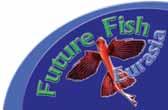



26-28 October 2022
China Fisheries and Seafood Expo Qingdao, CHina seafoodchina@seafare.com info@seafarechina.com
2-5 November 2022
Busan International Seafood & Fisheries Expo Busan, Korea Tel.: +82-51-740-7518,7519 bisfe@bexco.co.kr www.bisfe.com
3-5 November 2022
Future Fish Eurasia Izmir, Turkey Tel: +90 212 347 10 55 info@eurasiafairs.com www.eurasiafairs.com
17 November 2022
International Cold Water Prawn Forum (ICWPF) Tromsø, Norway Tel.: +45 4079 1011 jm@gemba.dk https://icwpf.com/


29 November – 2 December 2022
World Aquaculture Singapore 2022 Singapore mario@marevent.com https://www.was.org/meeting/code/WA2020
13-15 December
AlgaEurope Rome, Italy info@dlg-benelux.com https://algaeurope.org/


15-16 February 2023
AquaFarm Prodenone, Italy Tel.: +39 0434 232 111 pdeodorico@fierapordenone.it https://www.aquafarm.show/en/
Aquaculture America 2023 New Orleans, Louisiana, USA mario@marevent.com
7-9 March 2023
North Atlantic Seafood Forum Bergen, Norway +47 4811 4196 andre@nor-seafood.no
12-14 March 2023
Seafood Expo North America Boston, USA Tel.: +1 207 842 5590 sales-na@seafoodexpo.com https://www.seafoodexpo.com/north-america/

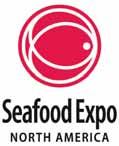
Seafood Expo Global Barcelona, Spain
Tel.: +1 207 842 5590 sales-global@seafoodexpo.com www.seafoodexpo.com
Add your event to www.eurofish.dk



















The specialist in fishbox compactors and recycling Tel. +45 97371799 runi@runi.dk www.runi.dk






Robert-Koch-Straße
D-22851 Hamburg-Norderstedt Tel.: +49 40 7131472 Fax: +49 40 71370166 info@salmco.com www.salmco.com
